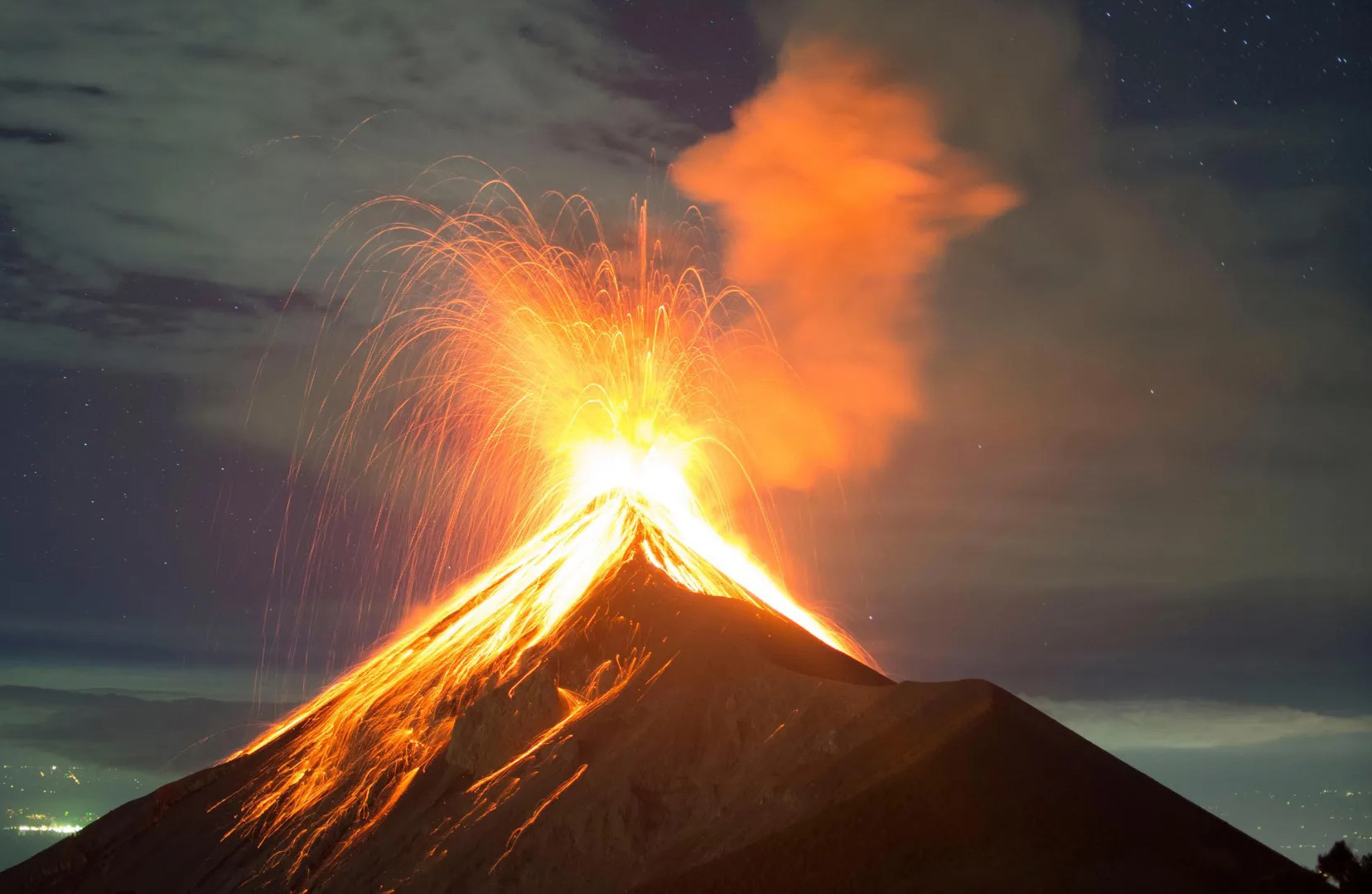
The mystery of volcanoes that don't explode finally has an answer Science Daily - November 22, 2025

The force of a volcanic eruption is closely tied to how many gas bubbles appear within rising magma, as well as the timing of their formation. For many years, scientists believed that most bubbles developed only when magma ascended and the surrounding pressure fell. In deeper layers, high pressure keeps gases dissolved in the molten rock, but once that pressure decreases, these gases escape and create bubbles. As bubbles accumulate, the magma becomes more buoyant and rises faster, sometimes tearing apart and erupting explosively.
It's really an extraordinary story,' historian Steven Tuck says of the Romans he tracked who survived the AD 79 eruption of Mount Vesuvius Live Science - October 20, 2025
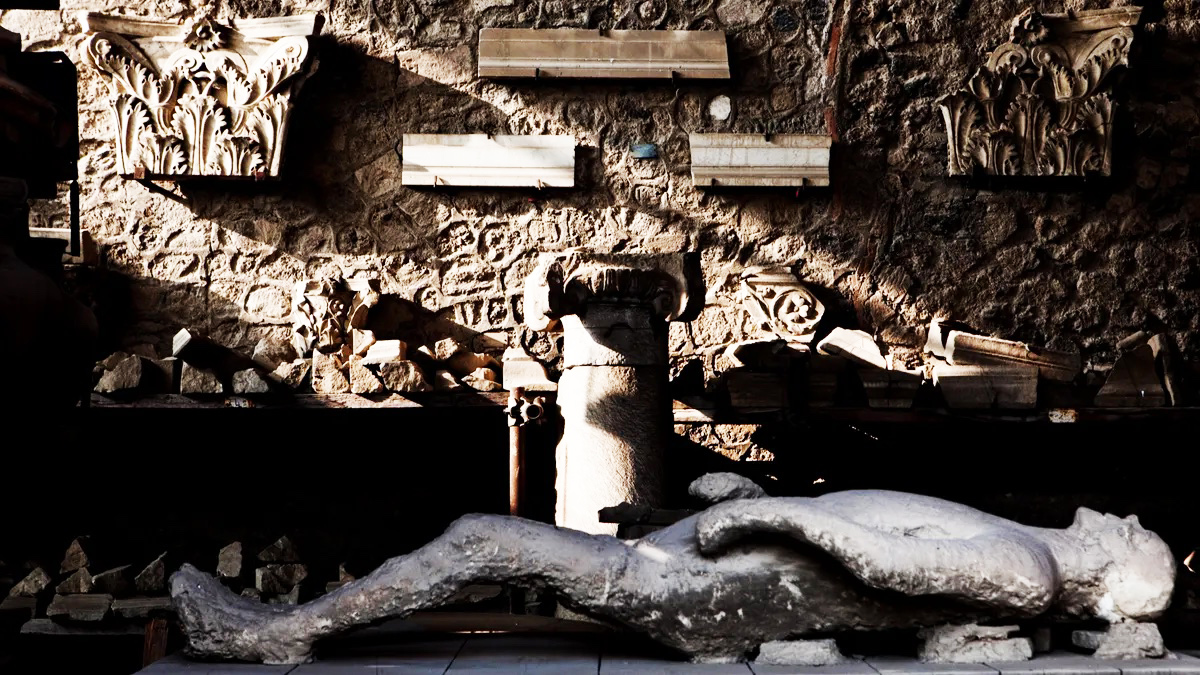
People made it out of the cities alive: tracing the survivors of Pompeii and Herculaneum, 2000 years after Vesuvius erupted Live Science - October 20, 2025
An Iranian volcano called Taftan - appears to have woken up 700,000 years after its last eruption Live Science - October 16, 2025

Taftan volcano near the border of Pakistan has shown signs of unrest in recent years.
A pair of volcanic lakes appear to stare into space from the Chiltepe Peninsula of Nicaragua's Lake Managua. These "eyes" and "skull" were created by violent eruptions thousands of years ago. Live Science - September 16, 2025

These "eyes" and "skull" were created by violent eruptions thousands of years ago.
Archaeologists have discovered new evidence pointing to the reoccupation of Pompeii following the 79 AD eruption of Mount Vesuvius that left the city in ruins Science Alert - August 7, 2025

Despite the massive destruction suffered by Pompeii, an ancient Roman city home to more than 20,000 people before the eruption, some survivors who could not afford to start a new life elsewhere are believed to have returned to live in the devastated area.
A parade of volcanoes is erupting in Russia following an 8.8 earthquake Live Science - August 5, 2025

A volcano on Russia's far eastern Kamchatka Peninsula erupted overnight into Sunday for what scientists said is the first time in hundreds of years and days after the massive 8.8-magnitude earthquake last week PhysOrg - August 4, 2025

The eruption was accompanied by a 7.0-magnitude earthquake and prompted a tsunami warning for three areas of Kamchatka. The tsunami warning was later lifted by Russia's Ministry for Emergency Services.

2025 Kamchatka Peninsula Earthquake Wikipedia
Tsunami waves hit US shores after 8.8 magnitude quake strikes Russia's far east - 6th most powerful ever recorded CNN - July 30, 2025
The region is known for seismic activity due to its location in the Pacific Ring of Fire - a belt in the Pacific where the world's most active volcanoes are located. Russian volcano explodes in 'powerful' eruption, likely intensified by 8.8 magnitude earthquake Live Science - July 30, 2025
Climate change and natural disasters continue to accelerate exponentially as we move to closure. This summer has seen unprecedented global flooding and extreme heat. All of the tectonic plates are broken or fractured highlighted with the Pacific Plate.
The 8.8 pacific earthquake could have affected this predicted volcano event ... Undersea Volcano Off The US West Coast Predicted To Erupt In 2025
Video: 'Rope Volcano' hits Gary, South Dakota Weather.com - June 28, 2025

First Signs of a 'Ghost' or Mantle Plume Reshaping Earth Detected Beneath Oman Science Alert - June 18, 2025

Scientists believe they've discovered a 'ghost' plume for the first time. Rising from Earth's core beneath Oman, the unusually elusive column of hot rock shows no surface volcanic activity, unlike typical plumes. With or without visible disruption on the surface, mantle plumes are thought to play a crucial role in the interplay of heat, pressure, and movement all the way down to the center of the planet. Understanding ghost plumes and where they're located can help scientists learn more in areas like plate tectonics, the evolution of life, and Earth's magnetic field.
Volcanic Eruptions Can Create Ice in The Sky, And We Finally Know How Science Alert - June 10, 2025


Huge eruption on Italy's Mount Etna leaves tourists fleeing volcano as a combination of ash, rock, and toxic gases CNN - June 3, 2025
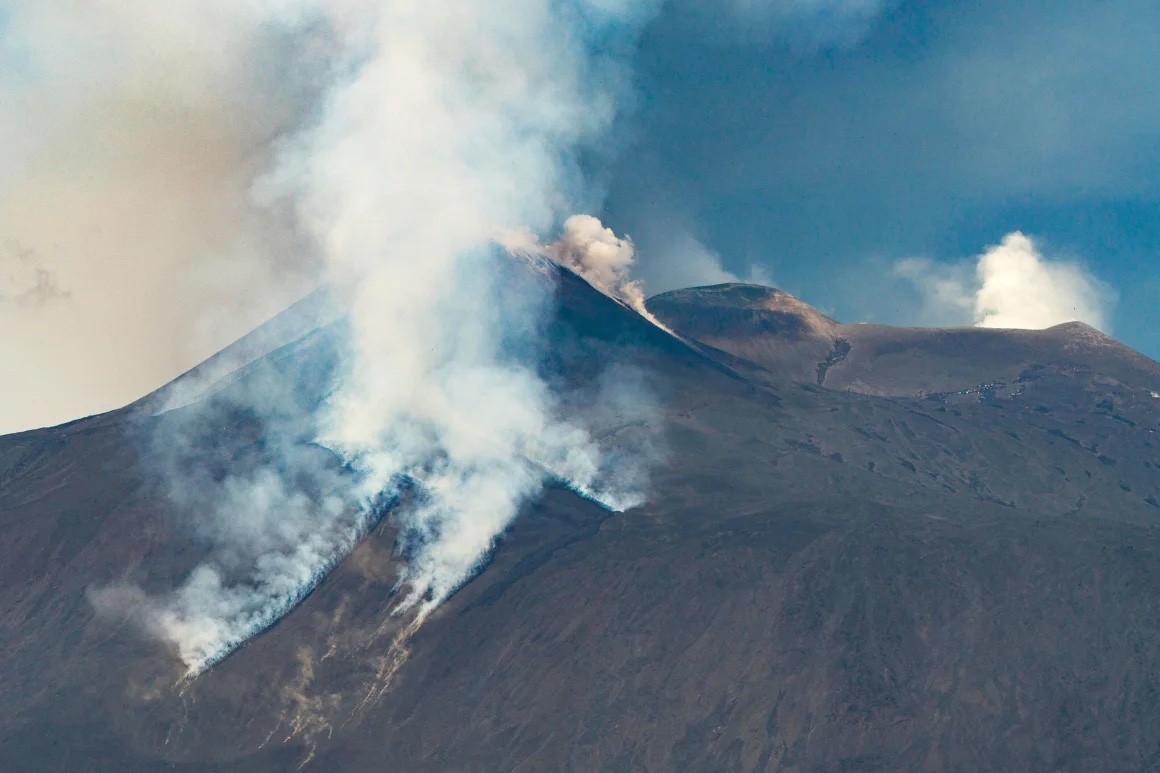
Although Mount Etna is one of the world’s most active volcanoes, there hasn’t been an eruption of this magnitude since 2014, according to the observatory. These eruptions often stop as quickly as they start, the observatory added, though explosions are still increasing in intensity and the mountain is spewing out a very small amount of lava and fire.
Pyroclastic flows, also known as pyroclastic density currents or pyroclastic clouds, are fast-moving, destructive volcanic phenomena consisting of hot gas and volcanic matter. They travel down the slopes of volcanoes, driven by gravity, and can reach speeds of up to 700 km/h (430 mph). These flows are incredibly hot and dangerous, capable of incinerating everything in their path.
Pyroclastic clouds buried Pompeii in 79 AD. The eruption of Mount Vesuvius in 79 AD caused a massive pyroclastic flow that devastated Pompeii and other nearby towns. This flow was a superheated, high-speed avalanche of hot gas, ash, and volcanic debris that incinerated and buried everything in its path.
Quadruple volcanoes on secret Soviet military base linked to climate-altering eruption 200 years ago - along the Russian island of Simushir. Live Science - May 28, 2025
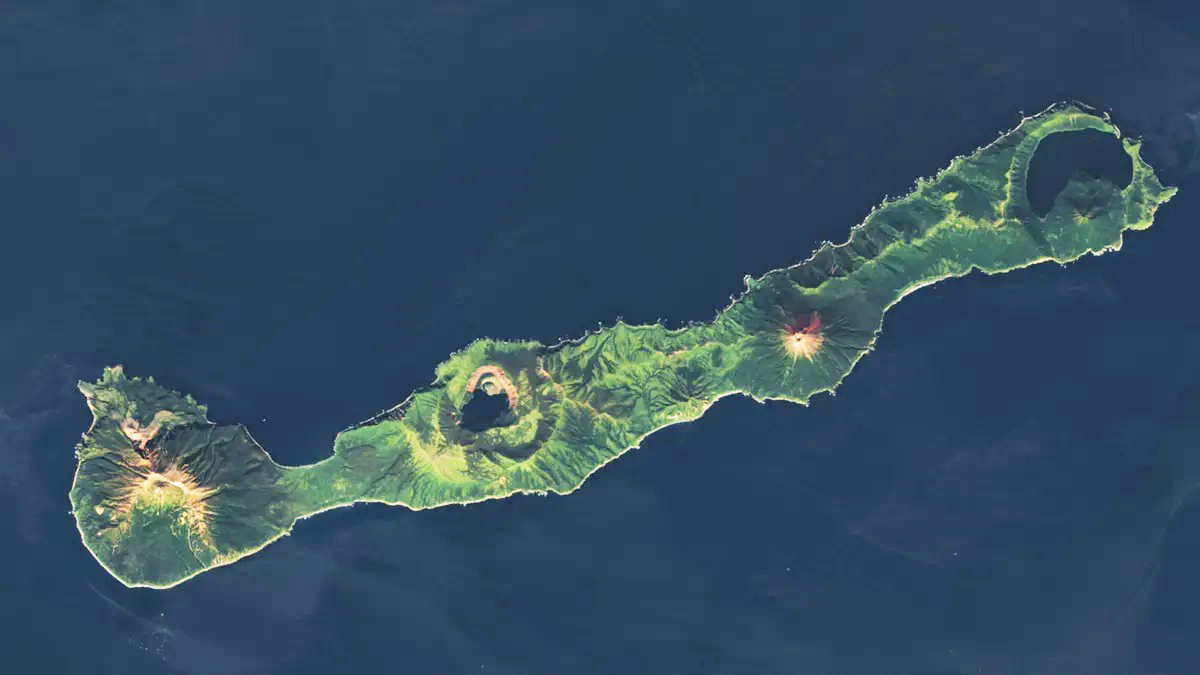
One of these peaks was the site of a surprise eruption that temporarily cooled the Northern Hemisphere in 1831. Simushir is one of the Kuril Islands - a Russian-controlled archipelago of more than 50 volcanic islands in the North Pacific Ocean. Like the rest of the Kuril Islands, the sovereignty of Simushir has been passed back and forth between two nearby countries, Russia and Japan, several times over the last 400 years. It was most recently used as a secret Soviet nuclear submarine base until 1994, but is now uninhabited. The 5-mile-long (8 kilometer) landmass is home to four major volcanoes that can be seen from space. These towering structures are, from southeast to northwest (left to right): Milna, Zavaritski, Prevo and Uratman.
Hawaiian volcanic rocks reveal Earth's core contains vast hidden gold reserves PhysOrg - May 22, 2025

Earth's largest gold reserves are not kept inside Fort Knox, the United States Bullion Depository. In fact, they are hidden much deeper in the ground than one would expect. More than 99.999% of Earth's stores of gold and other precious metals lie buried under 3,000 km of solid rock, locked away within Earth's metallic core and far beyond the reaches of humankind.
Axial Seamount showing signs of approaching eruption as magma builds up off Oregon coast Watchers - May 1, 2025
Axial Seamount, an underwater volcano off the Pacific Northwest coast, could erupt soon for the first time in a decade. Scientists at the University of Washington have detected a sharp increase in small undersea earthquakes and seafloor inflation - signs of magma buildup within the volcano. Despite the activity, experts say there is no threat to coastal communities. The site remains under constant observation through one of the world’s most advanced ocean monitoring systems.
'The Big One' could rock the Pacific Northwest and fuel sea-level rise and massive flooding Live Science - May 1, 2025
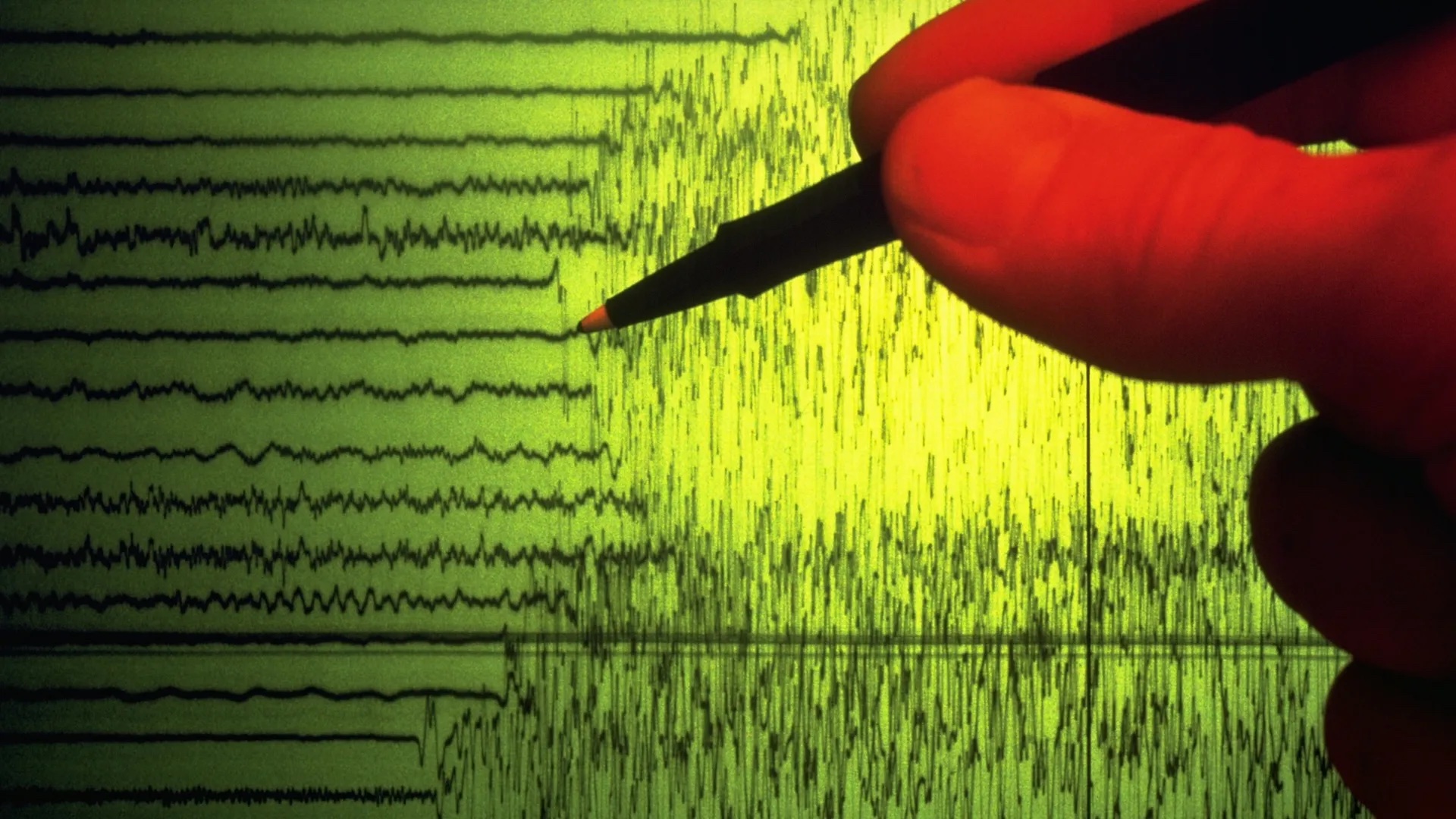
A catastrophic earthquake in the Cascadia region of the Pacific Northwest could lower the ground near the coast by up to 6.6 feet (2 meters). Combined with rising seas caused by climate change, that could create long-term flooding problems for coastal areas in northern California, Washington and Oregon, a new study finds. Such a quake would triple the amount of land in the 100-year floodplain in the Pacific Northwest by 2100, according to the study. "We talk a lot about the tsunami and about the shaking, but this subsidence could persist for decades to centuries.
An ocean of magma formed early in Earth's history and it may still influence our planet today, study finds Live Science - April 17, 2025

Remnants of a liquid layer of magma near Earth's core, formed in the first few hundred million years of the planet's history, may still persist today as odd anomalies in the mantle.
Epi and Tongoa: How two cultures diverged after an island-splitting volcanic eruption PhysOrg - March 18, 2025

A recent study published in Archaeology in Oceania explores the oral, linguistic, genetic and archaeological evidence surrounding the Tombuk volcanic eruption. The resulting data highlights the profound cultural and demographic shifts experienced by the two emergent islands created in the aftermath of the eruption. Today, the Vanuatu archipelago consists of 83 islands in the southwest Pacific. It is among the most disaster-prone regions worldwide, annually experiencing various natural disasters, including tropical cyclones, floods, landslides, earthquakes, and/or volcanic eruptions. More than 500 years ago, in AD 1452, the island of Kuwae experienced a massive catastrophe known as the Tombuk eruption. The eruption created a massive caldera (a depression formed by a volcanic eruption), effectively splitting the island in two. The northwestern portion became the island of Epi, with a landmass of about 445 km2. Meanwhile, the southern portion became the island of Tongoa, encompassing only around 45 km2.
Mount Washington is home to the world's worst weather with record wind speeds of 231 mph Live Science - March 14, 2025

Earth beneath Washington state has been shaking - experts are on high alert. The largest active volcano in the state sits there - and researchers are worried it could blow MSN - March 14, 2025

Satellite view shows active lava flow cutting through snow-covered Mount Etna Watchers - February 15, 2025

Recent observations indicate that the eruptive activity, which began on February 6, produced lava flows, Strombolian explosions, and intermittent ash emissions.
'Incredible moment in history:' Particle accelerator and AI offer first peek inside 2,000-year-old Herculaneum scroll Live Science - February 7, 2025

First glimpse inside burnt scroll charred by the volcanic eruption of Mount Vesuvius in 79AD BBC - February 5, 2025

Using a combination of X-ray imaging and artificial intelligence to virtually unfurl the document it revealed rows and columns of text.
'Disgust' among first words decoded in 2,000-year-old charred scroll CNN - February 9, 2025
Santorini, a Greek island, is steeped in myths and legends that are rich with spiritual significance. The island's volcanic origins, dramatic caldera, and connection to the myth of Atlantis have captivated people's imaginations for centuries.

Thousands evacuate Santorini as earthquakes strike island BBC - February 4, 2025
Authorities remain on high alert as the region continues to experience strong earthquakes including 43 tremors above M4.0 since February 1. The Watchers - February 4, 2025
The Most Active Volcano in The Northeast Pacific Is Preparing to Erupt - Underwater peak called Axial Seamount is located 300 miles off Oregon's coast Science Alert - January 28, 2025
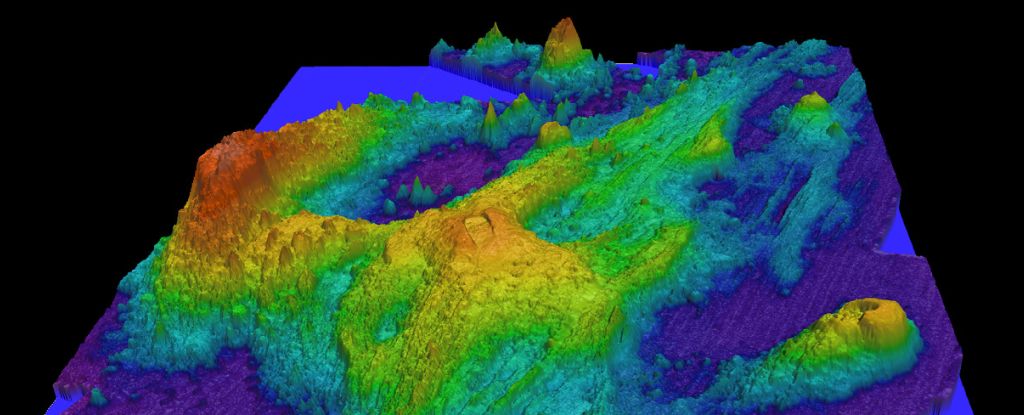
Earth bubbles and broils beneath an underwater peak called Axial Seamount, located 480 kilometers (300 miles) off Oregon's coast, causing it to swell in changing patterns that hint at impending strife.
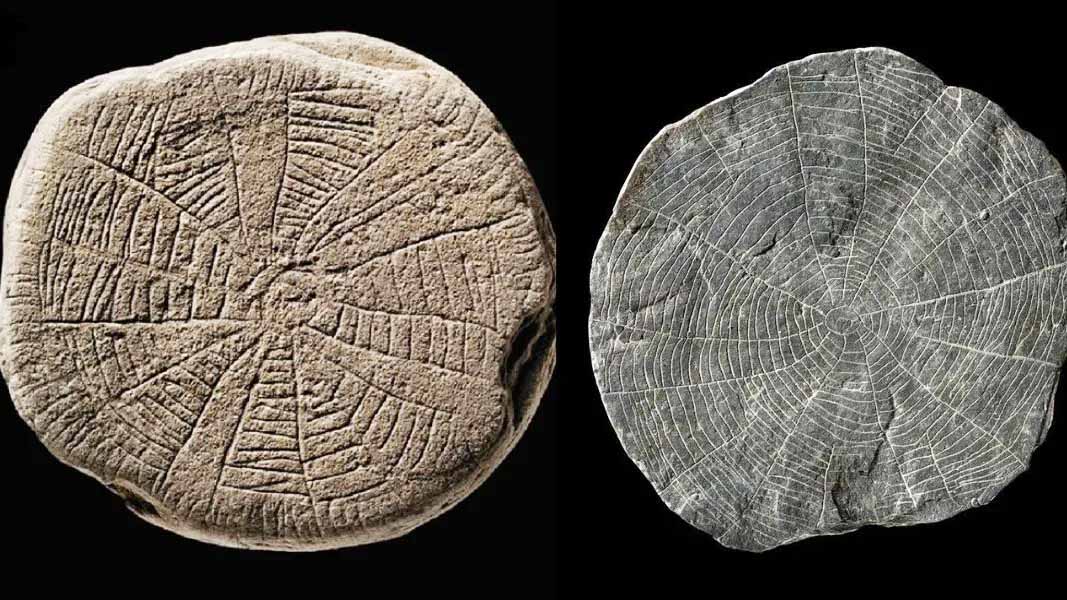
Ancient Stones Were Mysteriously 'Sacrificed' around 4,900 years ago when a volcano erupted so massively that it would have blotted out the Sun - prompting the ritual sacrifice of sun stones in a bid to restore it Science Alert - January 16, 202
Volcanic eruptions linked to Neolithic 'sun stone' sacrifices in Denmark PhysOrg - January 16, 2025
Stone Age people made sun stone 'sacrifice' to banish 'darkened sun' after a volcanic eruption, archaeologists say Live Science - January 16, 2025
Hundreds of stone artifacts discovered on a Danish island may have been offered to the gods to ward off a climate crisis.
In August 1831, The Sun Appeared Blue - And We Now Know Why
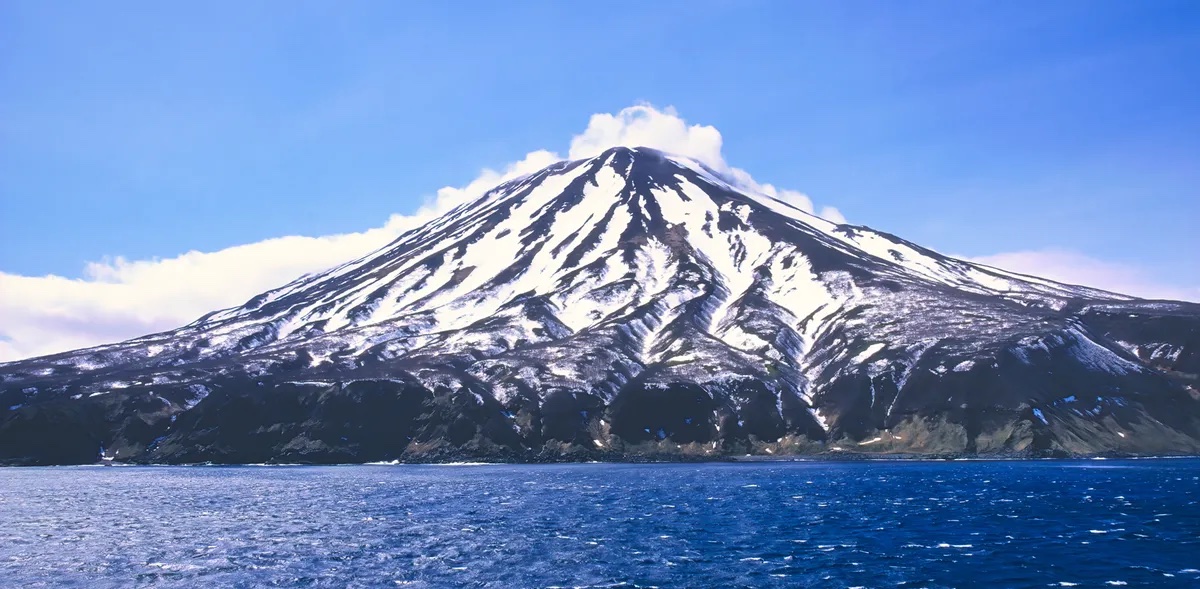
In August 1831, reports also emerged from around the world - including China, Europe, the US, and the Caribbean - of the Sun appearing "blue, purple, and green." This phenomenon was likely caused by volcanic dust and gases scattering sunlight in an unusual way. This phenomenon was likely caused by volcanic dust and gases scattering sunlight in an unusual way. This phenomenon was likely caused by volcanic dust and gases scattering sunlight in an unusual way.
Antarctic ice melt may fuel eruptions of 100 hidden volcanoes PhysOrg - January 6, 2025

A slow climate feedback loop may be bubbling beneath Antarctica's vast ice sheet. The continent, divided east to west by the Transantarctic Mountains, includes volcanic giants such as Mount Erebus and its iconic lava lake. But at least 100 less conspicuous volcanoes dot Antarctica, with many clustered along its western coast. Some of those volcanoes peak above the surface, but others sit several kilometers beneath the Antarctic Ice Sheet.
Scientists Discover Mystery Volcano That Cooled The Globe in 1831 Science Alert - January 4, 2025
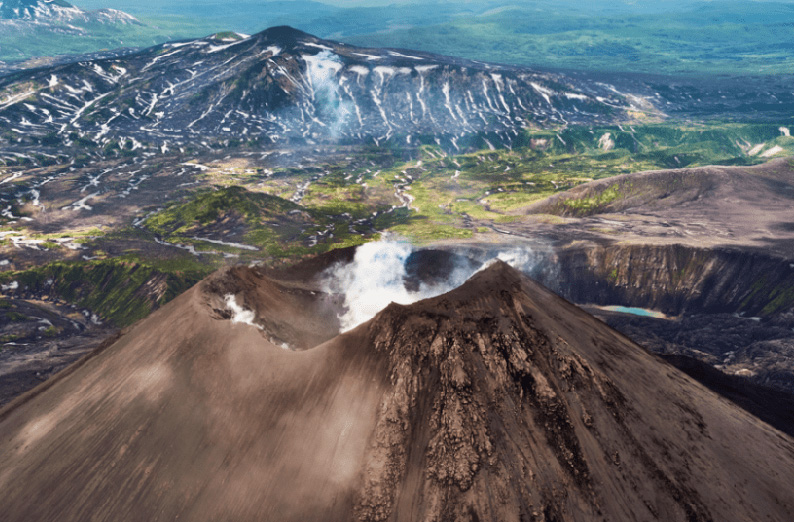
The world-changing event has at last been linked with the Zavaritskii volcano on Simushir of the Kuril Islands, an uninhibited strip of land barely 59 kilometers (37 miles) in length located between Russia and Japan. Today there is lots of earthquake activity in the Kuril region.
Undersea Volcano Off The US West Coast Predicted To Erupt In 2025 Live Science - December 30, 2024

A submarine volcano near Oregon looks like it could erupt at any time, and scientists have stuck their necks out by predicting that the event will occur before the end of 2025. Forecasting volcanic eruptions with more than a few hours' notice is currently a huge challenge, yet researchers have identified an undersea volcano called Axial Seamount as the perfect place to start practicing. Located on the Juan de Fuca Ridge, some 480 kilometers (300 miles) off the US west coast, Axial is the most active submarine volcano in the northeast Pacific, erupting with sufficient regularity for scientists to try and study the patterns that precede these blow-outs.
The next massive volcanic eruption is coming. It will cause chaos the world is not prepared for. Let's go back to the year 1815 ... CNN - December 24, 2024

Mount Tambora changed the world. In 1815, the Indonesian volcano exploded in the most powerful eruption in recorded history, sending an enormous plume of tiny sun-reflecting particles high into the atmosphere, cooling the planet and ushering in disaster. What followed was called the 'year without a summer:' global temperatures plunged, crops failed, people starved, a cholera pandemic spread and tens of thousands died. Some even credit the volcano with inspiring Mary Shelley to write Frankenstein, while sheltering from unusually cold weather in Switzerland in 1816.
Tanzania: The Ol Doinyo Lengai Volcano's Lava Flows Are So Cold It's Possible To Fall In And Survive. Ol Doinyo Lengai, or 'Mountain of God', is a contender for the weirdest volcano in the world. IFL Science - December 20, 2024
Pompeii victims aren't who we thought they were, DNA analysis reveals Live Science - November 7, 2024
A research team concluded that the victims had a diverse genomic background, primarily descending from recent eastern Mediterranean immigrants confirming the Roman Empire's multiethnic reality.
The Pacific Plate is breaking up.
Record spike in earthquakes at Washington's 'high threat' Mount Adams volcano sends researchers scrambling for answers Live Science - October 5, 2024
Six earthquakes were recorded at the Mount Adams volcano in September - a significant increase on the normal rate of one every two to three years.
Rare Earth Metals Found in Extinct Volcanoes Could Power The Future Science Alert - September 25, 2024

Extinct volcanoes are hard to study – we never see them erupt. Using a unique experimental technique, we were able to recreate a certain type of extinct volcano in a lab, learning more about the magma these volcanoes produce.
The Vesuvius challenge is using AI to virtually unroll Pompeii's ancient scrolls PhysOrg - August 30, 2024

The Vesuvius Challenge is an unparalleled competition in the field of classical studies, with the potential to pave the way for something akin to a second Renaissance. Its objective is to use artificial intelligence (AI) to virtually unroll hundreds of closed papyrus scrolls, containing ancient literature that has not been seen for 2,000 years.
Sapphires form inside the fiery hearts of volcanoes, not deep in the mantle like we thought Live Science - August 6, 2024
A new study of sapphires found in volcanic fields in Germany reveals that these beautiful blue stones form where magma and rocks from Earth's crust mix.
This Volcano Spews Out Black Watery Lava, The Weirdest Magma On Earth IFL Science - August 3, 2024
When you think of a volcanic eruption, you probably imagine a glowing red parade of thick lava marching down the slopes of a fiery mountain. Yet that’s not the case at Ol Doinyo Lengai, the only volcano on Earth that spews black, watery lava that behaves in ways that scientists still don’t fully understand. Ol Doinyo Lengai has been erupting continuously since 2017.
Tanzania's Ol Doinyo Lengai volcano, the only volcano on Earth that is currently erupting carbonatite lava, has been sinking at a rate of 1.4 inches per year for the past decade. Live Science - August 2, 2024
A volcano in Tanzania with magma that erupts like a garden hose has been steadily sinking into the ground for the past 10 years, a new study shows, and the cause could be a deflating reservoir directly beneath one of the volcano's two craters.
Sediments reveal the ancient ocean during a mass extinction event PhysOrg - June 25, 2024
About 183 million years ago, volcanic activity in modern South Africa unleashed an estimated 20,500 gigatons of carbon dioxide (CO2) into the ocean–atmosphere system over a period of 300 to 500 thousand years. Known as the Toarcian Oceanic Anoxic Event (T-OAE), the lack of oxygen, or anoxia, in the water during this time caused a mass extinction of marine species. Human activity since the industrial revolution has already resulted in cumulative CO2 emissions representing 12% of the total CO2 released during the entire T-OAE, in less than 0.1% of the time. The T-OAE foreshadows what might happen to our oceans if greenhouse gas emissions continue to increase.
The heart of an ancient volcano in Norway hosts Europe's largest deposit of rare earth elements Live Science - June 13, 2024
Ancient Roman Site Found Frozen in Time in The Wreckage of Pompeii Science Alert - April 7, 2024
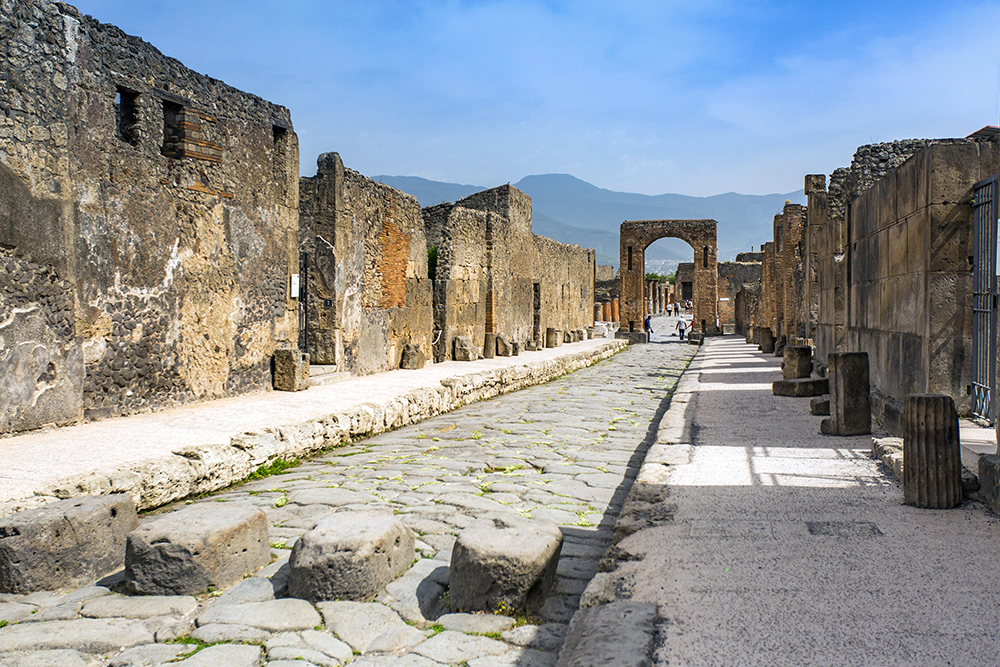
Archaeologists have found an unusual treasure that has been buried for nearly 2,000 years under the ash and debris that rained down from the catastrophic eruption of Vesuvius, in 79 CE. In the rooms of an ancient home, or domus, excavations have revealed a construction site, in perfect condition. That includes tools, unused tiles, bricks hewn from volcanic material called tuff, and the piece de resistance - piles of lime to mix Ancient Roman concrete. Home renovation may seem somewhat mundane, but the discovery gives us a pristine snapshot of how the Ancient Romans constructed the buildings in which they lived. And it also reveals some new information about the construction techniques that produced buildings that are still standing, thousands of years later.
Iceland violent volcanic flare-up triggers state of emergency on the Reykjanes Peninsula - the fourth since December BBC - March 17, 2024
Lava has reached the eastern defenses around the small, evacuated town of Grindavik, local media said.

Some of these texts could completely rewrite the history of key periods of the ancient world.
AI Helps Decipher Herculaneum Scroll That Hasn't Been Read In 2,000 Years IFL Science - February 6, 2024
Underwater Santorini volcano eruption 520,000 years ago was 15 times bigger than record-breaking Tonga eruption Live Science - January 26, 2024
A 500-foot-thick layer of pumice rock on the Mediterranean seabed indicates Santorini volcano ejected 15 times more material than Hunga-Tonga during a previously unknown eruption. A giant layer of pumice and ash, which is up to 500 feet (150 meters) thick, revealed that around half a million years ago, the Santorini volcano erupted so explosively it was 15 times more violent than the Hunga Tonga-Hunga Ha'apai eruption of 2022. The Tonga eruption shattered several records, triggering the fastest atmospheric waves ever seen and the first known mega-tsunami since antiquity.
Fountains of diamonds that erupt from Earth's center are revealing the lost history of supercontinents Live Science - January 15, 2024
Diamonds seem to reach Earth's surface in massive volcanic eruptions when supercontinents break up, and they form when continents come together.
Iceland volcano eruption weakening as fissure contracts north of the small fishing village of Grindavik BBC - December 19, 2023
Photos: Rivers and fountains of red-gold volcanic lava light up the dark skies in Icelandic town Phys.org - December 20, 2023
More stunning Pics Live Science - December 20, 2023
Study examines how massive January 15, 2022 eruption changed stratosphere chemistry and dynamics and produced a shock wave felt around the world triggering tsunamis in Tonga, Fiji, New Zealand, Japan, Chile, Peru and the United States PhysOrg - November 22, 2023

It also changed the chemistry and dynamics of the stratosphere in the year following the eruption, leading to unprecedented losses in the ozone layer of up to 7% over large areas of the Southern Hemisphere.
Washington's volcanoes are experiencing seismic tremors from an unlikely source - glaciers PhysOrg - October 23, 2023
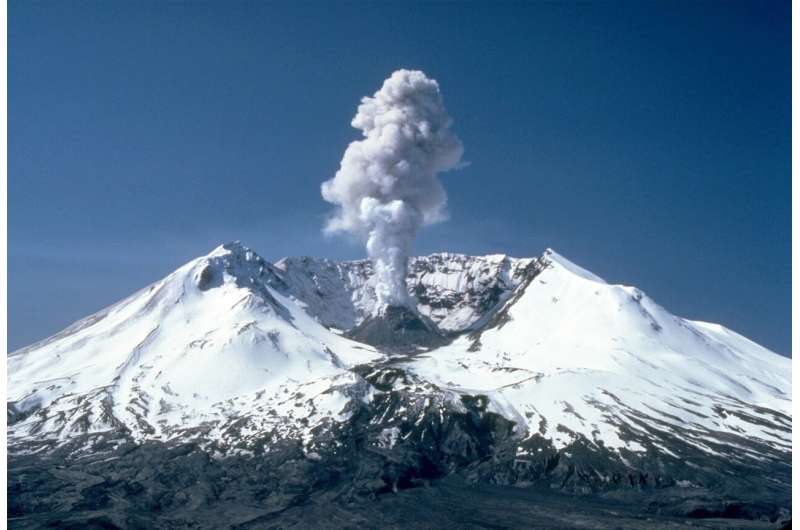
Decades ago, scientists who research seismic activity in the Washington Cascades recorded a number of small seismic events and eventually determined that they were caused by glacier movement. These events, called "glacier quakes," allow for important insight into seismic activity, patterns of glacier movement and even climate events.
Perilous expedition to uninhabited island in South Atlantic confirms existence of world's 8th lava lake Live Science - October 24, 2023
A new National Geographic "Explorer" episode follows an expedition to Saunders Island and the first documented ascent of Mount Michael, a volcano hosting the world's eighth lava lake.
A dormant supervolcano in California's Eastern Sierra Nevada mountains lets off the occasional earthquake swarm, but new evidence suggests it's simmering down Live Science - October 24, 2023
A shuddering supervolcano in California is simmering down, not ramping up, thanks to a giant lid that is covering its magma reservoir, new research finds. The Long Valley Caldera in the Eastern Sierra Nevada mountains has been unleashing earthquake swarms on a regular basis since 1978, raising concerns that it might be at risk of erupting. That would be a big deal, as the caldera was created 767,000 years ago with an explosion that released 156 cubic miles (650 cubic kilometers) of ash - enough to bury Los Angeles 0.6 mile (1 kilometer) deep in dust.
AI Deciphers Ancient Scroll Buried in The Ashes of Mount Vesuvius Science Alert - October 16, 2023

As you might imagine for a scroll that has been buried under mounds of volcanic ash from Mount Vesuvius for close to 2,000 years, the rolled-up papyrus excavated from the ancient Roman city of Herculaneum is rather difficult to open, let alone read – but AI has found a way.
North Atlantic volcanic activity was a major driver of climate change 56 million years ago, study finds PhysOrg - August 21, 2023

Fountains of diamonds erupt from Earth's center as supercontinents break up Live Science - August 20, 2023
Researchers have discovered a pattern where diamonds spew from deep beneath Earth's surface in huge, explosive volcanic eruptions.
New geology study cracks the code of what causes diamonds to erupt PhysOrg - July 27, 2023
We've Discovered How Diamonds Make Their Way To The Surface And It May Tell Us Where To Find Them IFL Science - July 27, 2023
New research, carried out by researchers in a variety of countries and published in Nature, suggests that diamonds may be a sign of break up too - of Earth’s tectonic plates, that is. It may even provide clues to where is best to go looking for them. Diamonds, being the hardest naturally-occurring stones, require intense pressures and temperatures to form. These conditions are only achieved deep within the Earth. So how do they get from deep within the Earth, up to the surface? Diamonds are carried up in molten rocks, or magmas, called kimberlites. Until now, we didn’t know what process caused kimberlites to suddenly shoot through the Earth’s crust having spent millions, or even billions, of years stowed away under the continents.
Africa Is Splitting Into Two And New Data Is Uncovering How IFL Science - August 19, 2023
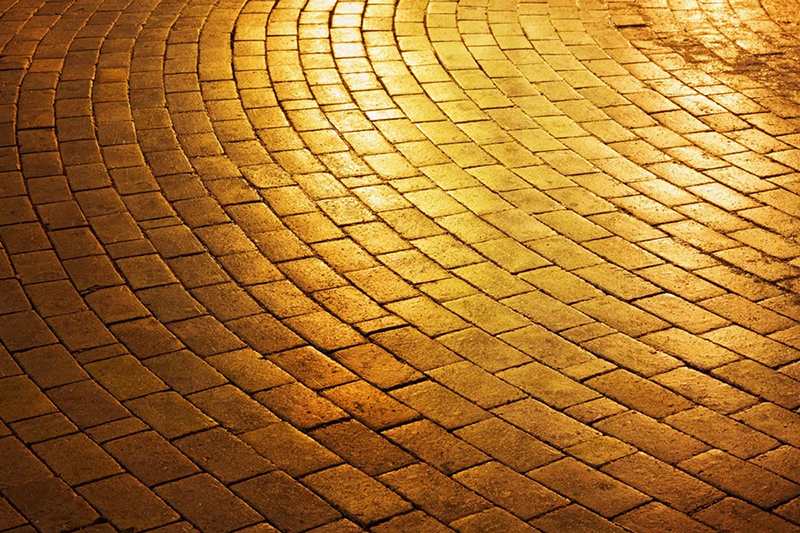
Volcanoes like Kilauea and Mauna Loa don't erupt like we thought they did, scientists discover Live Science - August 9, 2023
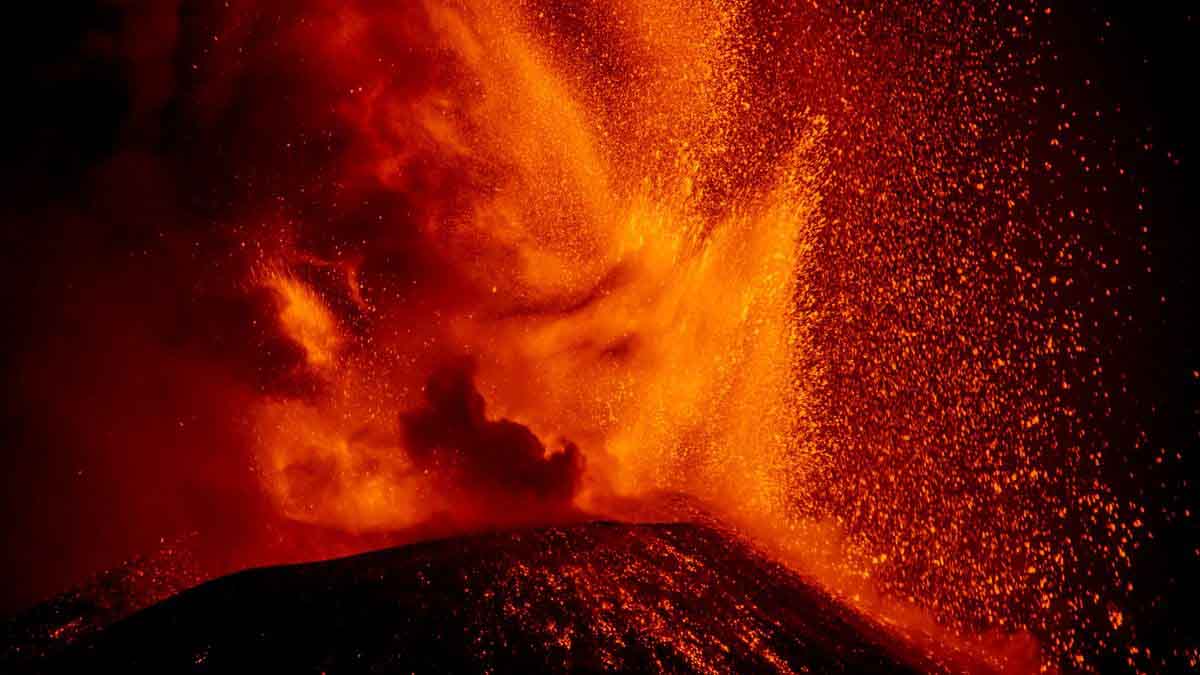
Volcanoes that sit within Earth's tectonic plates don't erupt how scientists thought they did. It turns out, magma within these volcanoes is propelled up and out of the ground by carbon dioxide - not by water, as was previously thought, a new study finds. This magma also shoots up from much deeper reserves than previously estimated, originating in Earth's mantle at depths of 12 to 19 miles (20 to 30 kilometers), rather than in the outer crust, 4 to 8 miles (7 to 13 km) deep.
Iceland's newest volcano is now spewing out tornadoes Live Science - August 5, 2023
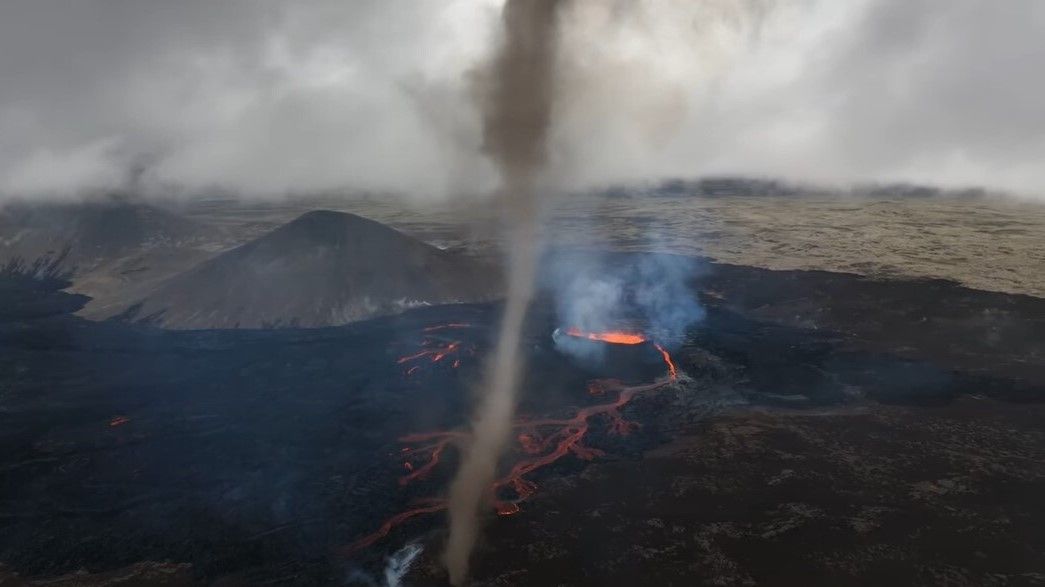
Iceland's newborn volcano is announcing its arrival with a bang, spewing out methane explosions and tornadoes to complement the ribbons of lava painting the landscape.
Deadly swarm of earthquakes in Japan caused by magma moving through extinct volcano Live Science - August 3, 2023
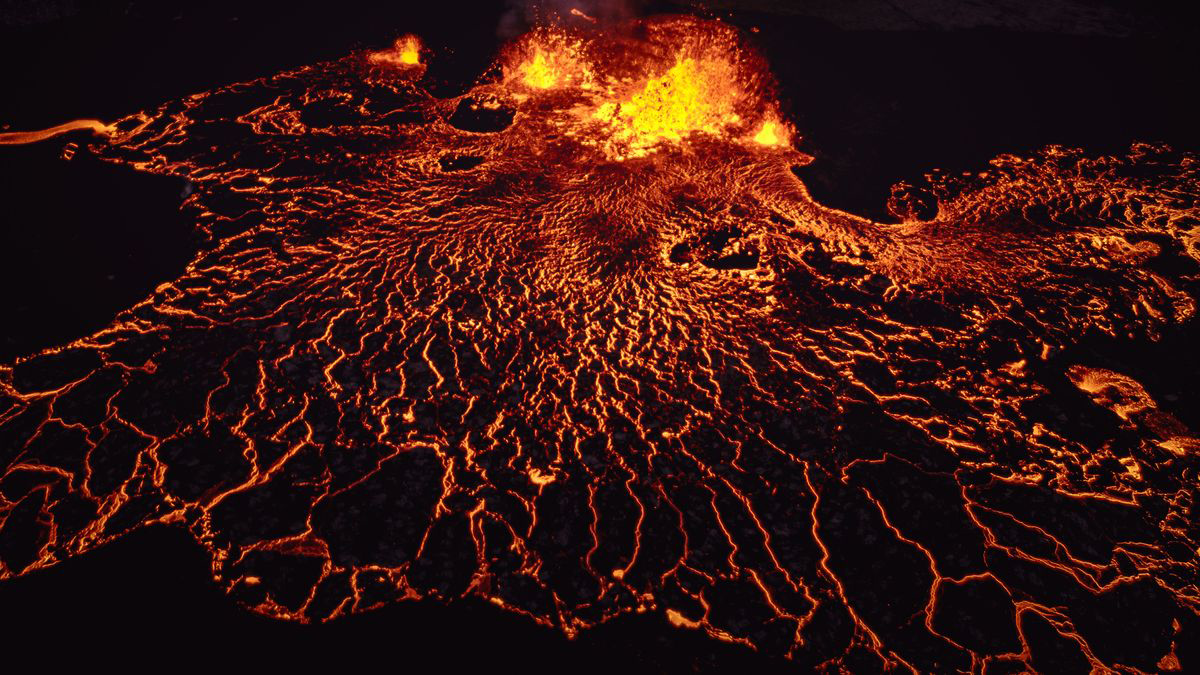
A huge swarm of earthquakes that has been rocking Japan for three years appears to be the result of fluids moving through an extinct, collapsed volcano, new research suggests. The swarm is happening on the Noto Peninsula by the Sea of Japan, on the north coast of the country. There has not been volcanic activity in this area for 15.6 million years. However, a new study published June 8 in the journal JGR Solid Earth found that the quakes are occurring in a pattern that suggests liquid magma is still moving around deep below the surface in an ancient, collapsed caldera.
Iceland's 'baby volcano' is still spewing lava rivers, in a tantrum visible from space Live Science - July 27, 2023
Drone footage captures Iceland's "baby volcano" throwing a hissy fit, spewing molten lava into the sky.
Eerily perfect 'vortex rings' keep blowing out of Europe's most active volcano. Here's why. Live Science - July 27, 2023
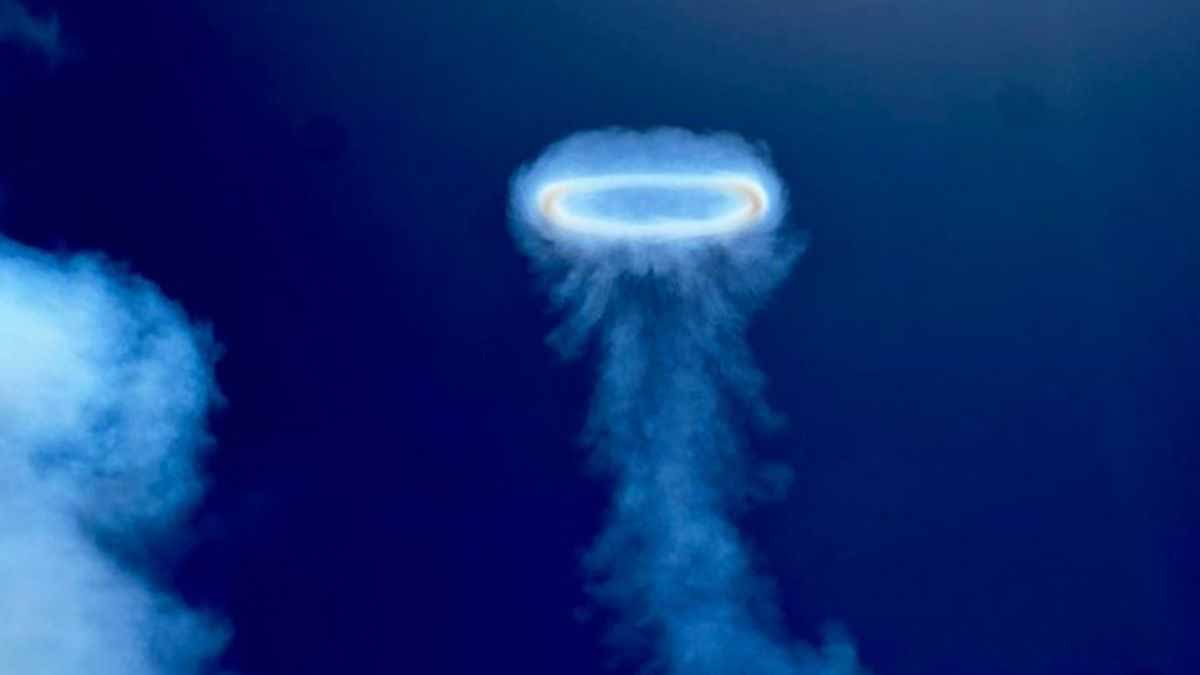

Europe's most active volcano, Mount Etna, is blowing scores of ethereal "vortex rings" every day from a single vent located in one of its most active craters.

Researchers discovered that an underwater volcano nearly a mile beneath the surface off the Pacific coast of Canada is spouting hot fluid, providing a little-known species of skate with an ideal nursery.
Europe's most dangerous 'supervolcano' - Italy's Campi Flegrei - could be creeping toward eruption, scientists warn Live Science - June 9, 2023
Italy's Campi Flegrei is showing some troubling early warning signs, but scientists caution that its eruption is far from certain. A long-slumbering "supervolcano" in Italy is getting closer to a potential eruption for the first time since 1538, a new study warns - and the consequences could be catastrophic. The Campi Flegrei volcano, near Naples in southern Italy, has crust that is becoming weaker and more prone to rupturing, "making an eruption more likely", scientists behind a new study have said. More than 1.5 million people live above the vast underground volcano complex, and half a million people have their homes inside its 7-mile-long (11 kilometers) caldera, which was formed after an enormous eruption 39,000 years ago.
Philippines evacuates people near Mayon Volcano, where more unrest indicates eruption may be coming PhysOrg - June 9, 2023
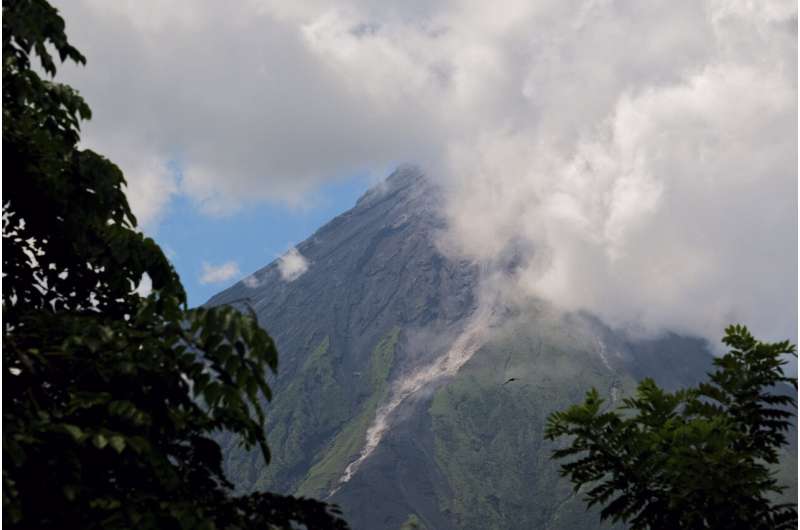
Philippine troops, police and rescue workers began forcibly evacuating residents near Mayon Volcano today as its increasing unrest indicated a violent eruption of one of the country's most active volcanoes is possible within weeks or days.

CNN: Authorities raise alert level as Kilauea volcano erupts CNN - June 7, 2023
BBC: Watch Hawaii's Kilauea volcano erupting in fiery display BBC - June 7, 2023
Iron-rich rocks unlock new insights into Earth's planetary history PhysOrg - May 26, 2023
Visually striking layers of burnt orange, yellow, silver, brown and blue-tinged black are characteristic of banded iron formations, sedimentary rocks that may have prompted some of the largest volcanic eruptions in Earth's history,
Millions in Mexico warned to prepare for evacuation as Popocatepetl volcano spews ash CNN - May 23, 2023
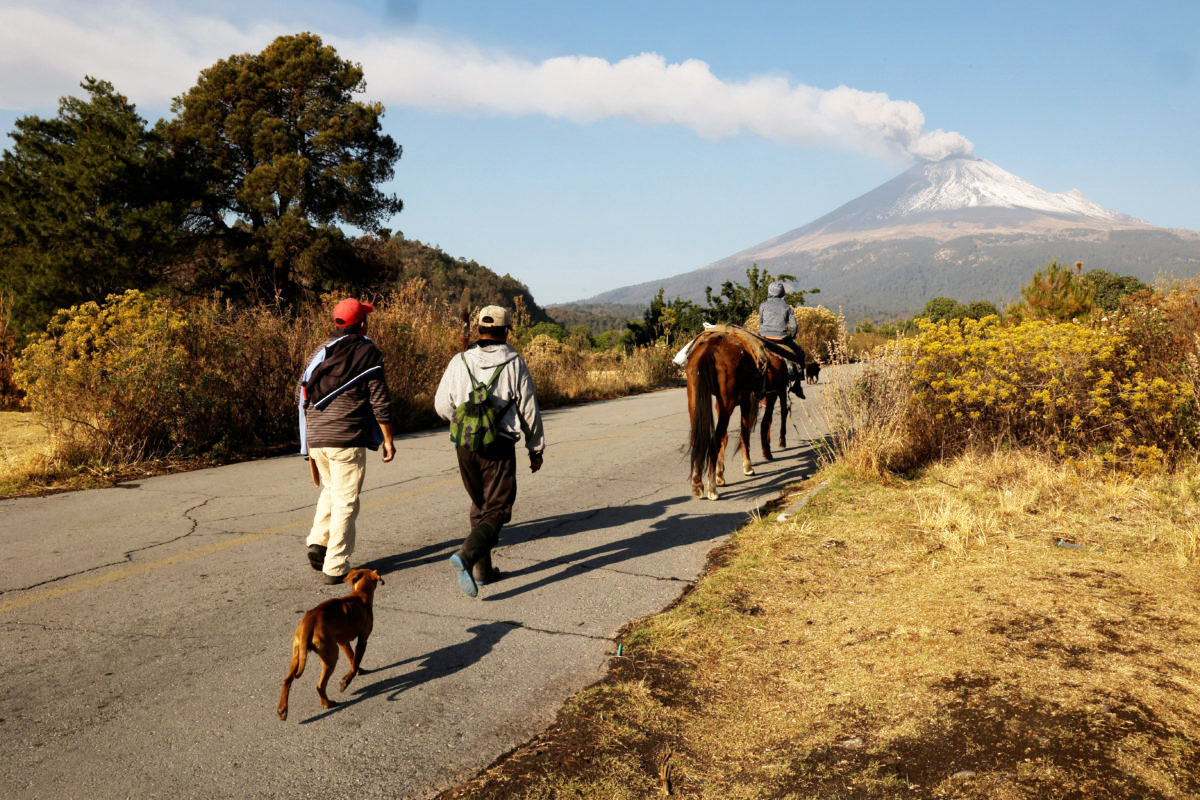
Millions of people in Mexico have been warned to prepare for a possible evacuation after increased activity from the country’s most dangerous active volcano, which has been spewing ash into several nearby towns since last week, according to authorities.
Mount Etna volcano erupts, raining ash on Catania, forcing flight suspension at local airport PhysOrg - May 21, 2023
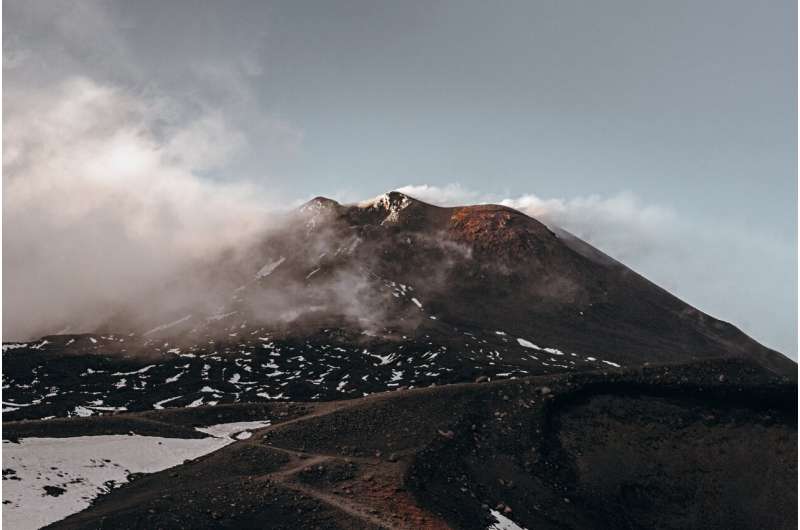
Italy's National Institute of Geophysics and Volcanology which closely monitors Etna with instrumentation on the slopes, noted that cloud cover on a rainy day was impeding views of the eruption, which often serves up a spectacular display of flaming lava during the volcano's not infrequent eruptions.
'High-definition radar satellites have revealed more than 19,000 undersea volcanoes around our planet, providing scientists with the most comprehensive catalog of seamounts ever created Live Science - April 28, 2023
The new compendium could provide a better understanding of ocean currents, plate tectonics and climate change.
Suspected Mass Extinction Was Actually A Volcanic Double-Punch 3 Million Years Apart IFL Science - April 11, 2023
During the Capitanian age 260 million years ago, the oceans suffered a drastic loss of oxygen causing, or perhaps amplifying, widespread global extinctions. Then 3 million years later the same thing happened again, sediment records reveal. The findings could explain a major point of confusion about the Permian period, a time overshadowed by its catastrophic ending in the greatest mass extinction event of all.
Swarm of quakes at Alaska volcano could mean eruption coming PhysOrg - March 9, 2023
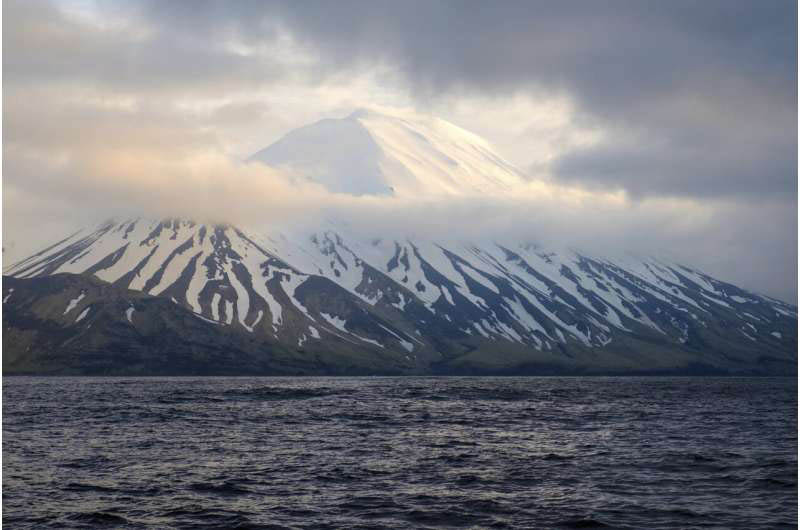
The Alaska Volcano Observatory raised the alert level to advisory status for Tanaga Volcano late Tuesday after the quakes became very vigorous. There have been hundreds of small earthquakes, none larger than magnitude 2.75, but they are concentrated beneath the summit of the volcano, he said.
Life in the smoke of underwater volcanoes PhysOrg - March 8, 2023
Deep down in the ocean at tectonic plate boundaries, hot fluids rise from hydrothermal vents. The fluids are devoid of oxygen and contain large amounts of metals such as iron, manganese or copper. Some may also transport sulfides, methane and hydrogen. When the hot water mixes with the cold and oxygenated surrounding sea
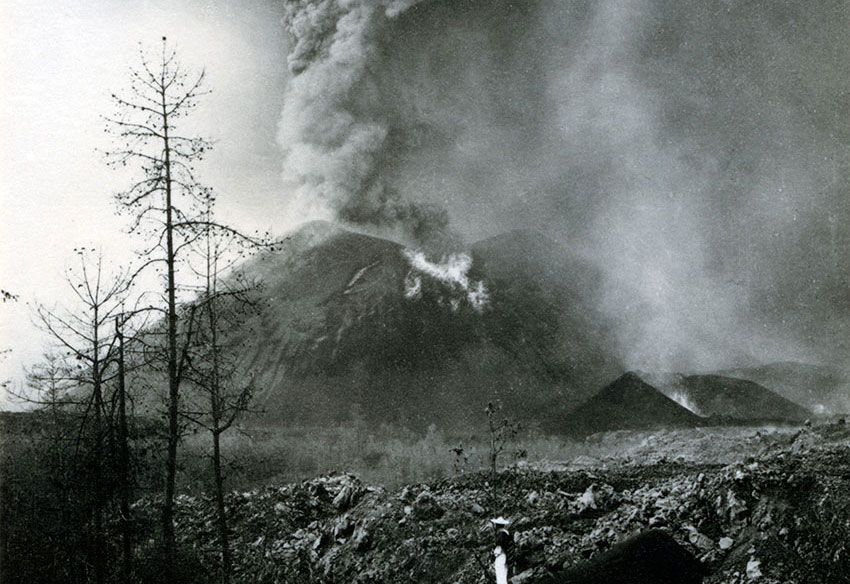
Eighty years ago, the day started like any other for farmer Dionisio Pulido and his family near the village of Paricutin, Mexico. But that afternoon, while burning shrubbery on his farm, Pulido and his wife, Paula, noticed something strange: The earth in front of them swelled upward and cracked, forming a fissure.
Returning to his work, Pulido was interrupted when, in his words, "I felt a thunder, the trees trembled, and I turned to speak to Paula; and it was then I saw how, in the hole, the ground swelled and raised itself 2 or 2.5 meters high, and a kind of smoke or fine dust - grey, like ashes - began to rise up in a portion of the crack that I had not previously seen. Immediately more smoke began to rise with a hiss or whistle, loud and continuous; and there was a smell of sulfur."
Within a week, the volcano in Pulido's cornfield had grown 165 feet high. In the space of months, its lava covered two evacuated villages. The Paricutin volcano, which went dormant in 1952, gave scientists a unique opportunity to study a volcano almost from its birth. It is now a tourist attraction, and its story inspired the 1997 film 'Volcano.'
Even While Dormant, Volcanoes Leak Climate-Changing Gasses Into The Atmosphere Science Alert - February 9, 2023
We know volcanoes can cause dramatic shifts in the atmosphere when they erupt, but what about those long stretches of time when they appear to have fallen silent? A new study suggests that dormant volcanoes could be leaking out much more sulfur than we thought. These findings are based on tiny particles trapped in layers of an ice core extracted from central Greenland, showing the make-up of the atmosphere circulating above the Arctic between the years 1200 and 1850. Sulfur emissions from dormant volcanoes were much higher than expected.
Throughout its lifetime, Newberry has been the most explosive volcano in the Cascades, with at least 5 caldera-forming eruptions in less than 300,000 years. The most recent caldera developed about 65,000 years ago, when explosive eruption of basaltic andesite to rhyolite created the current 6 x 8 km (3.7 x 5 miles) caldera.
Surprise magma chamber growing underneath Kolumbo, an active submarine volcano near Santorini, Greece PhysOrg - January 12, 2023
Nearly four hundred years ago, in 1650 C.E., Kolumbo breached the sea surface and erupted, killing 70 people in Santorini. This eruption, not to be confused with the catastrophic Thera (Santorini) volcanic eruption that occurred around 1600 B.C.E., was triggered by growing magma reservoirs beneath the surface of Kolumbo. Now researchers say the molten rock in the chamber is reaching a similar volume.
What Lies Beneath Yellowstone’s Volcano? Twice As Much Magma As Thought SciTech Daily - December 4, 2022
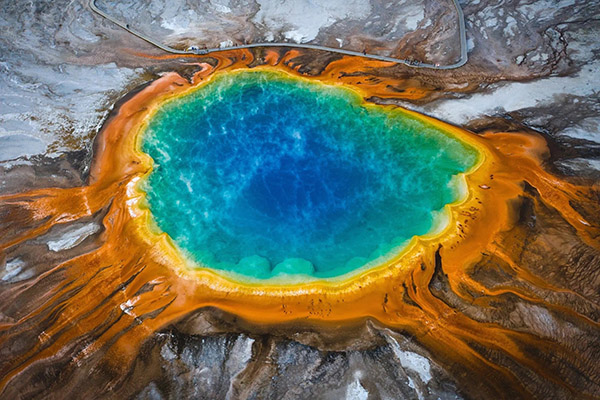 Previous images showed that Yellowstone’s volcano had a low concentration of magma - only 10% - surrounded by a solid crystalline framework. As a result of these new images, with key contributions from Chen, Maguire and his team were able to see that, in fact, twice that amount of magma exists within Yellowstone’s magmatic system.
Previous images showed that Yellowstone’s volcano had a low concentration of magma - only 10% - surrounded by a solid crystalline framework. As a result of these new images, with key contributions from Chen, Maguire and his team were able to see that, in fact, twice that amount of magma exists within Yellowstone’s magmatic system.
Are volcanoes impacted by climate change? Or is it the other way around? PhysOrg - December 6, 2022
While a study of Iceland proposes a possible link, scientists at Northeastern University say the effect of volcanic activity on global warming is minimal.

Mauna Loa
In 2022 the Pacific Plate - and those that connect to it - seem to be especially active with the Tonga eruption in January and the highlighted currently in Hawaii. Mauna Loa's eruption in Hawaii creates rare dual-eruption event with nearby volcano Kilauea, that's been erupting since 2021. Just 21 miles apart, the two volcanoes have not erupted together since 1984. Volcanic gas, fine ash and Pele's Hair (strands of volcanic glass) could be carried downwind. Also watching air quality and Vog.

Dozens of earthquakes swarm Hawaii - one of them a magnitude 4.2 - as the world's largest volcano erupts
Live Science - November 29, 2022
Viewers flock to watch glowing lava ooze from Hawaii volcano
PhysOrg - December 1, 2022
'Baby' island appears in Pacific Ocean after underwater volcano erupts CNN - September 24, 2022
The newborn island grew quickly in size, according to NASA. On September 14, researchers at Tonga Geological Services estimated the island covered just 4,000 square meters - around one acre.But by September 20, the island had grown to cover 24,000 square meters, or around 6 acres.
Tonga volcano eruption released more energy than the most powerful nuclear bomb PhysOrg - August 22, 2022
The eruption of the underwater volcano in Tonga that triggered a tsunami earlier this year (January 2022), released more energy than the Tsar Bomba the most powerful nuclear bomb ever detonated according to a new study.
Scientists Reveal The Full Danger of The World's Largest Active Volcano Mauna Loa Science Alert - August 3, 2022
Active for at least the last 700,000 years, and dominating the landscape of Hawaii, Mauna Loa is the largest shield volcano on Earth (above water, at least) – and scientific data reveals more about what might be enough to set off future eruptions.
Tonga's eruption injected so much water into Earth's atmosphere that it could weaken the ozone layer and contribute to global warming Live Science - August 1, 2022
When an underwater volcano in Tonga erupted in January, it belched out more than ash and volcanic gases; it also spewed 58,000 Olympic-size swimming pools' worth of water vapor into Earth's atmosphere, a new study finds.
Underwater volcano in Antarctica triggers 85,000 earthquakes - the strongest seismic outburst ever recorded in Antarctica Live Science - April 27, 2022
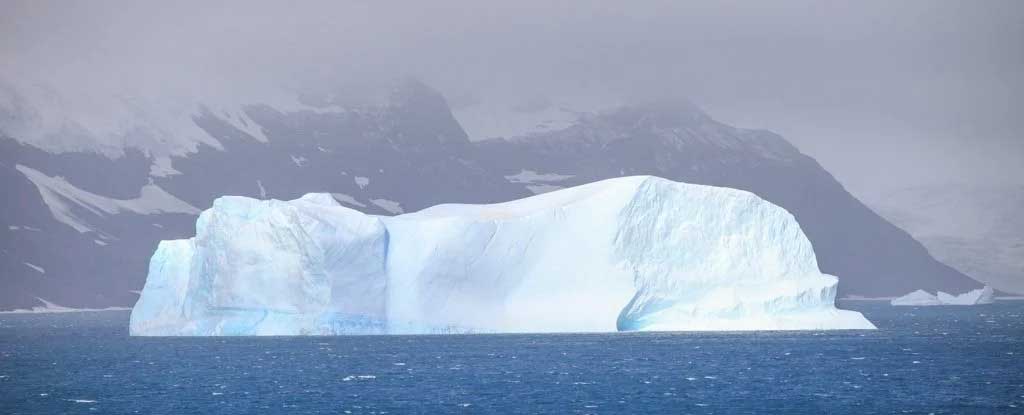
The quakes were likely caused by hot magma poking into the crust, new research finds.
Record-Breaking Earthquake Swarm Hits Antarctica as Sleeping Volcano Awakens Science Alert - April 28, 2022
The swarm occurred around the Orca Seamount, an inactive volcano that rises 2,950 feet (900 meters) from the seafloor in the Bransfield Strait, a narrow passage between the South Shetland Islands and the northwestern tip of Antarctica. In this region, the Phoenix tectonic plate is diving beneath the continental Antarctic plate, creating a network of fault zones, stretching some portions of the crust and opening rifts in other places
Oregon Volcanoes - 'The Bulge' is back: USGS scientists detect renewed uplift near South Sister volcano - February 1, 2022
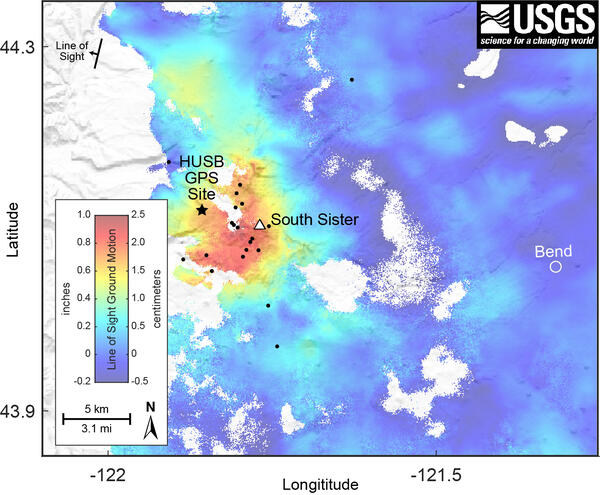
Some two decades after first drawing widespread attention, a small (but detectable by satellite) uplift near the South Sister volcano is making news once again, with a quicker rate of rising ground than seen for years, accompanied by some small but noticeable, shallow earthquakes. But an eruption, geologists assure, is not in the cards any time soon.
The Three Sisters are closely spaced volcanic peaks in the U.S. state of Oregon. Wikipedia
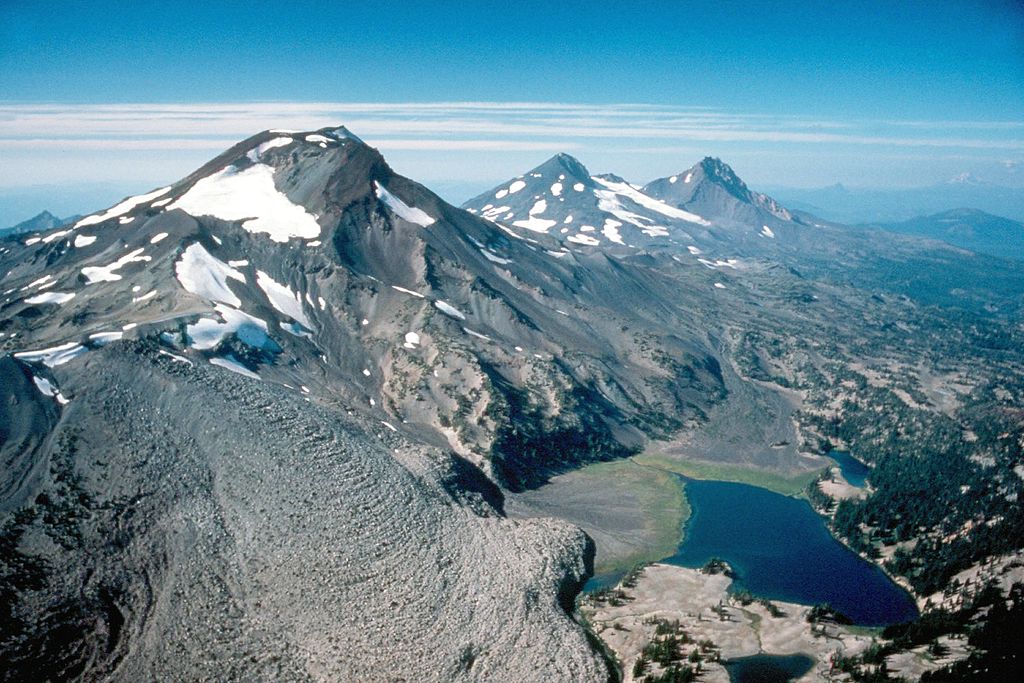
Although they are often grouped together as one unit, the three mountains have their own individual geology and eruptive history. Neither North Sister nor Middle Sister has erupted in the last 14,000 years, and it is considered unlikely that either will ever erupt again. South Sister last erupted about 2,000 years ago and could erupt in the future, threatening life within the region. After satellite imagery detected tectonic uplift near South Sister in 2000, the United States Geological Survey improved monitoring in the immediate area.
=
Underwater volcanoes: How ocean color changes can signal an imminent eruption PhysOrg - January 24, 2022

The scale of a recent volcano eruption took the people of Tonga by surprise. Scientists monitoring the submarine volcano, Hunga Tonga-Hunga Ha'apai, were likewise caught off-guard, failing to foresee an explosion which would unleash a Pacific-wide tsunami. Scientists estimate that the blast may have been the loudest terrestrial event since the eruption of Krakatoa in 1883, while an organization that monitors nuclear tests went so far as to declare it the biggest thing they have ever seen.
The volcano had been active a few times in recent years, with moderate eruptions that only amounted to local disturbance. The lack of warning for an event this large left many wondering if there might be other volcanoes beneath the ocean similarly primed to blow. To study volcanoes and interpret whether they're likely to erupt, scientists mount them with different kinds of measuring equipment. Seismometers help them detect small tremors caused by magma moving under the ground, while gas samplers and thermal cameras can be used to track changes in gas concentrations and temperature as magma ascends from the depths.
It's rarely acknowledged, however, that most volcanic activity on Earth occurs beneath the sea. Submarine volcanoes are pretty much ubiquitous in all of the world's major oceans and it's estimated that 75% of the Earth's magma output comes from mid-ocean ridges. To make things trickier, many known submarine volcanoes are found far from land, and being underwater prevents scientists from observing any changes by conventional means. So how do we monitor them? Scientists have managed to install equipment that detects tell-tale tremors on the sea bed before.

2022 Hunga Tonga Eruption and Tsunami Wikipedia
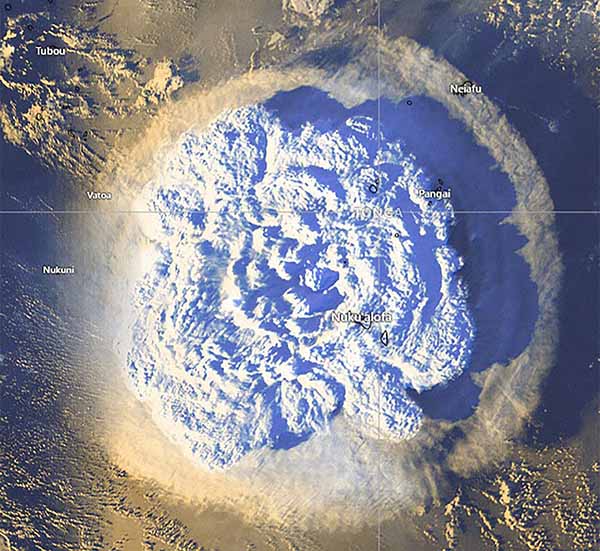
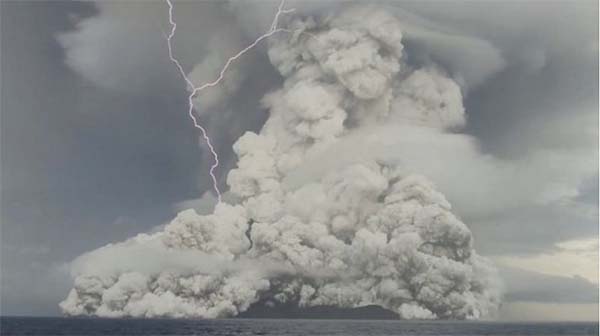
Tonga: Survivor tells of sea escape from tsunami-struck island
Tonga volcano: Plume reached half-way to space
The Tonga Volcanic Eruption Was So Powerful It Sent Ripples Out Into Space
Tonga eruption equivalent to hundreds of Hiroshimas: NASA
Tsunami Waves Over 4 Feet High Hit Pacific Coast after Major Eruption near Tonga
Waves between 1 and 4 feet were reported from California to Alaska Saturday after a tsunami advisory was issued because of a volcanic eruption in the South Pacific. The advisory was issued for Hawaii and the U.S. Pacific Coast including California, Oregon, Washington and parts of Alaska early Saturday morning after the undersea volcano erupted near the island nation of Tonga. A wave of 4.3 feet was reported in Port San Luis California, according to the National Weather Service. Large waves were also reported in King Cove, Alaska, La Push, Washington, and several other locations. Two people were transported to the hospital after being swept into the water Saturday afternoon at San Gregorio State Beach, according to local fire officials. One was taken by helicopter.
A toxic cloud spewing from an erupting volcano in Tonga could dump acid rainfall across the Pacific kingdom, potentially poisoning drinking water and damaging people's skin and eyes, emergency services have warned PhysOrg - December 22, 2021
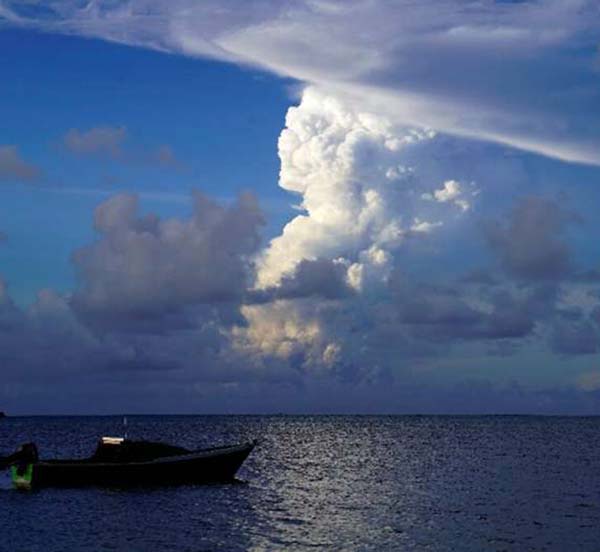
Police reported no injuries from the eruption but TGS said late Tuesday that the dust and gas could result in acidic rainfall if mixed with water in the atmosphere. It advised residents to remove guttering systems from their rainwater storage systems until the all-clear was given
Examining the 1,800-plus 'young' volcanoes in the US Southwest PhysOrg - November 3, 2021

They're born. They live once, erupting for a period that might last for days, years or decades. Then, they go dark and die.
This narrative describes the life of a monogenetic volcano, a type of volcanic hazard that can pose important dangers despite an ephemeral existence. The landscape of the southwestern U.S. is heavily scarred by past eruptions of such volcanoes, and a new study marks a step toward understanding future risks for the region.
Largest Underwater Eruption Ever Recorded Gives Birth to Massive New Volcano off the eastern coast of the island of Mayotte between the East African and Madagascar rifts Science Alert - September 30, 2021
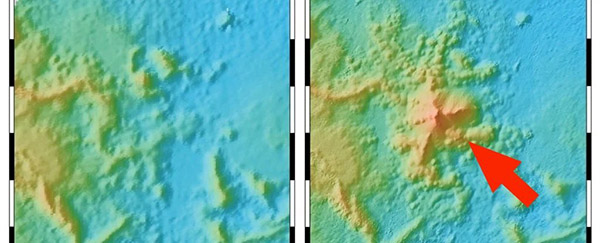
Off the eastern coast of the island of Mayotte, a gigantic new feature rises 820 meters (2,690 feet) from the seafloor, a prominence that hadn't been there prior to an earthquake that rocked the island in May 2018. The new feature, thought to be part of a tectonic structure between the East African and Madagascar rifts, is helping scientists understand deep Earth processes about which we know relatively little.
The seismic rumbles of the ongoing event started on 10 May 2018. Just a few days later, on 15 May, a magnitude 5.8 quake struck, rocking the nearby island. Initially, scientists were perplexed; but it didn't take long to figure out that a volcanic event had occurred, the likes of which had never been seen before. The signals pointed to a location around 50 kilometers from the Eastern coast of Mayotte, a French territory and part of the volcanic Comoros archipelago sandwiched between the Eastern coast of Africa and the Northern tip of Madagascar.
New island discovered after major submarine eruption at Fukutoku-Oka-no-Ba, Japan Watchers - August 17, 2021
A new island has been discovered some 50 km (31 miles) south of Iwo Jima, Ogasawara Islands, Japan just three days after a major submarine eruption at Fukutoku-Oka-no-Ba volcano. According to the Japan Meteorological Agency (JMA) the new island is approximately 1 km (0.62 miles) in diameter and C-shaped. It was discovered on Sunday, August 15. In addition, pumice created by the eruption was found by the coast floating across a 60 km (37 miles) area northwest of the island. New islands have been confirmed in the area in 1904, 1914, and 1986, with all having submerged, Kyodo reported. The one found in 1986 sank after around two months, according to the coast guard
Santorini: Volcanoes erupt more often when sea level drops Science News - August 10, 2021

When sea level drops far below the present-day level, the island volcano Santorini in Greece gets ready to rumble. A comparison of the activity of the volcano, which is now partially collapsed, with sea levels over the last 360,000 years reveals that when the sea level dips more than 40 meters below the present-day level, it triggers a fit of eruptions. During times of higher sea level, the volcano is quiet,
Volcanic tremor and deformation at Kilauea PhysOrg - August 4, 2021

Kilauea in Hawaii is the best-monitored volcano in the world. The 2018 eruption was the largest in some 200 years, providing researchers with a plethora of new data to understand the volcano's plumbing and behavior. Two new studies dig into data on volcanic tremor and deformation to better characterize the events leading up to and following the 2018 eruption.
Mt. Etna enters August with a violent paroxysmal eruptive episode Watchers - August 3, 2021

Etna entered August 2021 with continued growth at its Southeast Crater and impressive paroxysmal eruptive episode, the first since July 20. Strombolian activity at the crater gradually intensified into lava fountaining by 21:22 UTC on July 31. The episode lasted through 23:30 UTC, with lava fountains reaching a height of about 1 km (3 300 feet) a.s.l. A SW lava flow produced during the event reached an altitude of 2.8 km (9 200 feet) a.s.l. at 21:43 UTC.
Strong earthquake swarm at underwater volcano near Mayotte Watchers - August 3, 2021
A total of 186 LP earthquakes were recorded in three separate swarms, each associated with a very long-period earthquake (VLP), the Mayotte Volcanological and Seismological Monitoring Network (REVOSIMA) reports.
Scientists warn they have no accurate way to predict when an apocalyptic supervolcano explosion could occur because previous blasts were so rare and started in completely different ways Daily Mail - July 30, 2021
Volcanologists can predict when volcanos are going to erupt if they have a full detail of its eruptions. But for potentially apocalyptic supervolcanoes, such as the one bubbling under Yellowstone National Park, it's nearly impossible, given how varied their known eruptions have been, according to a new study. Researchers noted there is not a 'single model' that can help scientists understand how eruptions from supervolcanoes happen, making it difficult to understand when they might occur in the future.
More research needed to predict eruption of supervolcanoes PhysOrg - July 30, 2021
Scientists say it is extremely challenging to try and predict when a supervolcano might erupt again due to the sheer diversity of events that have gone before.

La Soufriere Volcano Wikipedia
New massive eruption at Soufriere St. Vincent,
SO2 emissions spreading over two continents - South America and Africa
The Watchers - April 13, 2021
Workers removing the ash

Email from a Crystalinks' reader in Barbados
Hi Ellie, It's Imran here in Barbados. We are currently experiencing ashfall from the La Soufriere volcano you reported about on St. Vincent. It's basically next door to us. It's surreal because the ash looks like snow. It's really end times stuff. Stay safe and keep well.
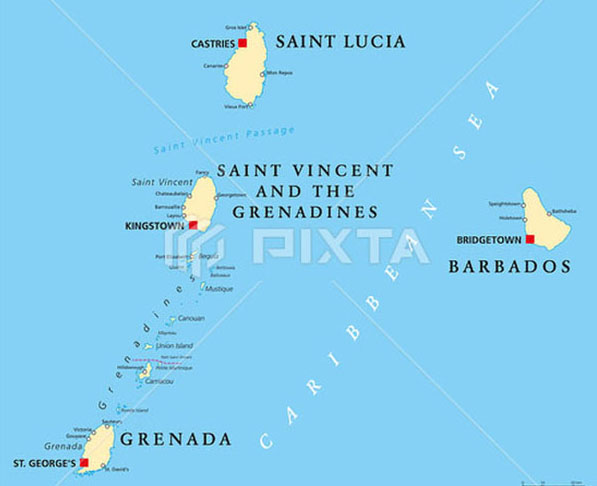
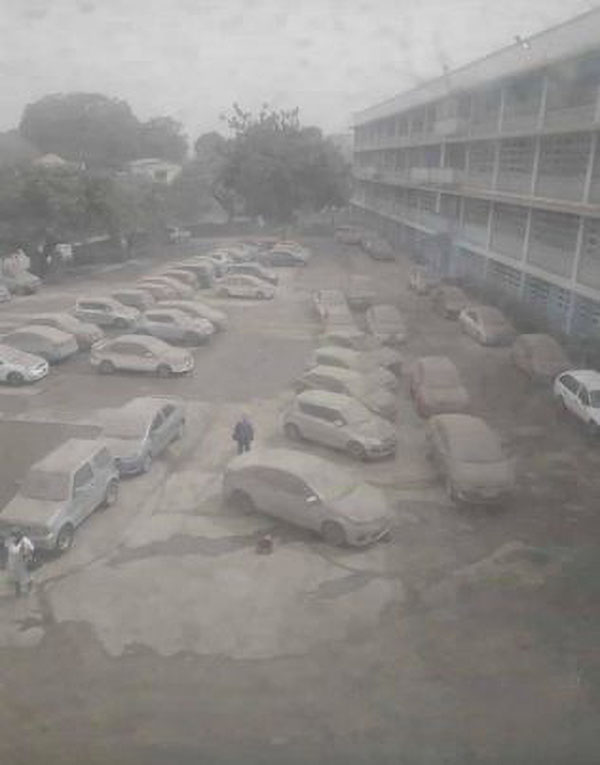

Italy's Mount Etna, Europe's most active volcano, has recently been on explosive form, with 17 eruptions in less than three months ScienceTech Daily - April 12, 2021
Italy's Mount Etna, Europe's most active volcano, has recently been on explosive form, with 17 eruptions in less than three months. Instruments onboard three different satellites orbiting Earth have acquired imagery of the eruptions - revealing the intensity of the lava-fountaining eruptive episodes, known as paroxysms. Located on the east coast of Sicily, Mount Etna is one of the world's most active volcanoes. Its eruptions occur at the summit, where there are four craters: the Voragine and the Bocca Nuova, formed in 1945 and 1928 respectively, the Northeast Crater, the highest point on Etna (3330 m) and the Southeast Crater, which has recently been the most active of the four.
Fagradalsfjall volcano (Reykjanes Peninsula, Iceland): 5th and 6th eruptive fissures opened Tuesday Volcano Discovery. - April 12, 2021
A volcanic eruption began on 19 March 2021 in Geldingadalir to the south of Fagradalsfjall, which is still emitting fresh lava as of 15 April 2021.
Mauna Loa, The World's Biggest Volcano, Is Waking Up And It's Time To Prep For An Eruption Forbes - April 12, 2021
Scientists monitoring the unsettled geological activity on Hawaii's biggest island say that while an eruption of the volcano that dominates the landscape isn't yet imminent, Mauna Loa's long nap may be coming to an end. The Big Island of Hawaii is really a collection of five volcanoes poking out of the Pacific Ocean, including one of the world's most active - Kilauea - and the world's largest: Mauna Loa, making up about half the island's land mass. Kilauea has been in the throes of a fiery, dramatic and sometimes destructive eruptive period for decades now. And while the smaller shield volcano on Mauna Loa's eastern slope garners international attention for its tantrums, its big sibling has been slumbering since it last erupted in 1984.
34 earthquakes rattle Mauna Loa, world's largest active volcano, and scientists say eruption possible The Hill - April 12, 2021
The Big Island of Hawaii, home to the world's largest active volcano, Mauna Loa, was rocked by 34 earthquakes on Sunday. While most of the earthquakes were low in magnitude, and none were strong enough to cause a tsunami, scientists warned citizens that an eruption from Mauna Loa could be possible in the near future.
In the three weeks prior to the eruption the area experiences over 5,000 earthquakes. This is all due to the rise of the Mid-Atlantic Ridge.
Mind-Blowing Photos Reveal Icelandic Eruption That Was 900 Years in The Making Science Alert - March 22, 2021
A volcano that spewed glowing red lava near Iceland's capital Reykjavik after awakening for the first time in 900 years appeared to be subsiding on Saturday, posing no danger to people, experts said.
Unusual earthquakes highlight central Utah volcanoes PhysOrg - March 2, 2021
If you drive south through central Utah on Interstate 15 and look west somewhere around Fillmore, you'll see smooth hills and fields of black rock. The area is, aptly, named the Black Rock Desert. It may not look like much, but you're looking at some of Utah's volcanoes. A pair of earthquake sequences, in September 2018 and April 2019, focused scientists' attention on the Black Rock Desert. The sequences, which included the main quakes and their aftershocks, were very different from the Magna earthquake that shook the Wasatch Front in 2020 and other Utah earthquakes. The Black Rock sequences were captured by the Utah Regional Seismic Network and by nearby temporary seismic equipment deployment that was monitoring a geothermal well. Earthquakes in the Black Rock Desert are rare and capturing the seismic recordings from these earthquakes provides a glimpse into the volcanic system of the Black Rock Desert that, while not showing any signs of erupting, is still active.
Indonesia's Mount Merapi, one of the world's most active volcanoes, erupted on Friday, belching out fiery red lava. PhysOrg - February 19, 2021
The volcano, close to Indonesia's cultural capital Yogyakarta on Java island, had already spewed lava almost two dozen times over the two last days and caused hundreds of minor volcanic quakes, according to a report by Indonesia's geological agency.
Spectacular eruption at Etna volcano, Italy Watchers - February 18, 2021
Another significant eruption started at Etna's Southeast crater just before 22:30 UTC on February 17, 2021, just 32 hours after the spectacular eruptive episode on February 16. A new paroxysm took place in the early hours of February 18, INGV reports. Like most paroxysms at Etna, it lasted only a few tens of minutes, from 01:00 to 01:45 UTC. This event was also characterized by high lava fountains, possibly reaching heights between 600 and 700 m (1 970 - 2 300 feet), and lava flows heading toward Valle del Bove and to the southwest. Strong ash emission started at around 00:00 UTC today, rising up to 9.1 km (30 000 feet) above sea level and drifting toward the southeast. The Aviation Color Code was raised to Red at 00:36 UTC and lowered back to Orange at 02:07 UTC. Ash and lapilli were reported southeast of the volcano, in areas such as Zafferana, Fleri, and Acireale.
Sicilian village cleans up ash, stones from Mt Etna eruption PhysOrg - February 17, 2021
Residents and municipal teams worked Wednesday to clean up a Sicilian village near Mount Etna after Europe's most active volcano spewed lava, ashes and volcanic stones. The eruption, which featured spectacular displays of gushing lava, forced the temporary closure of Sicily's Catania Airport, a frequent occurrence when Etna is in an active phase. As Tuesday's volcanic activity was largely expected, areas surrounding the crater were secured and there were no reported injuries or deaths. But nearby residents said the eruption was unusual in that big chunks of volcanic stones carpeted the area, not just ash.
Popocatepetl Volcano Volcanic Ash Advisory Volcano Discovery - February 17, 2021
Explosive activity continues. Volcanic Ash Advisory Center (VAAC) Washington warned about a volcanic ash plume that rose up to estimated 20000 ft (6100 m) altitude or flight level 200 .
Snow blankets Hawaii volcanoes in stunning satellite image
Live Science - February 12, 2021
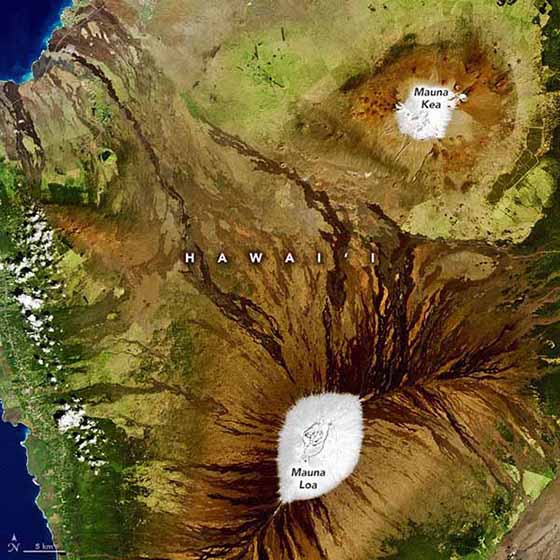
A new satellite image has captured the stunning white peaks of two volcanoes on the Big Island in Hawaii, which have experienced their second-most extensive snow coverage since current records began. The high-resolution image - snapped on Feb. 6 by the Operational Land Imager (OLI) onboard the Landsat-8 satellite - shows the striking contrast between the snow-covered peaks of Mauna Kea and Mauna Loa and the surrounding volcanic rock.
Dormant Volcano La Soufriere in St. Vincent The Caribbean Just Came Back to Life, Causing Evacuation Warnings Science Alert - January 4, 2021
Residents of St. Vincent and the Grenadines have been told to remain alert after a Caribbean volcano came back to life. La Soufrière is the highest point in St. Vincent and is located near the northern tip of the country but remained dormant for decades before beginning to spew ash on Tuesday this week, AP reported.
Scientists Discover Exotic New Mineral Forged in The Furnace of a Russian Volcano Science Alert - November 18, 2020

Researchers in Russia report the discovery of one such creation - an unusual mineral never before documented by scientists: an alluring, vibrantly blue-and-green crystallized substance the team have called petrovite.
Volcanic eruptions have more effect in summer PhysOrg - November 18, 2020
Detailed modeling of the effect of volcanic eruptions on the El Niño Southern Oscillation (ENSO) has shown that the climate response to these events depends on the timing of the eruption and the preceding conditions
Huge eruption of Italian volcano sends ash hundreds of feet into the air Live Science - November 16, 2020
An explosion on the slopes of Stromboli sent an avalanche of pyroclastic flow rushing down the side of the Italian volcano on Monday (Nov. 16). The stronger-than-usual explosion was captured on cameras operated by the Istituto Nazionale Geofisica e Vulcanologia (INGV). Imagery shared by Il Mondo dei Terremoti on Twitter shows the eruption in real-time; video captured by infrared cameras that shows the ultra-hot initial eruption and the slightly cooler cloud of ash and gases careening downslope. This avalanche of hot ash and gases is known as pyroclastic flow.
The Ilopango volcanic eruption that shocked the Maya's civilization 1590 years ago PhysOrg - September 29, 2020
In 431 CE, 1590 years ago, the Maya civilization was laid waste as the Ilopango volcano erupted, killing every living thing within 40 km around the volcano.
Researchers document the 'life cycle' of a volcano PhysOrg - September 10, 2020
Volcanoes are born and die - and then grow again on their own remains. The decay of a volcano in particular is often accompanied by catastrophic consequences, as was the most recent case for Anak Krakatau in 2018. The flank of the volcano had collapsed, sliding into the sea. The resulting tsunami killed several hundred people on Indonesia's coast.
How volcanoes explode in the deep sea PhysOrg - June 29, 2020
Most volcanic eruptions take place unseen at the bottom of the world's oceans. In recent years, oceanography has shown that this submarine volcanism not only deposits lava but also ejects large amounts of volcanic ash.
Eruption of Alaska's Okmok volcano linked to period of extreme cold in ancient Rome PhysOrg - June 22, 2020
An international team of scientists and historians has found evidence connecting an unexplained period of extreme cold in ancient Rome with an unlikely source: a massive eruption of Alaska's Okmok volcano, located on the opposite side of the Earth.
Hawaii just got a new and the largest shield volcano on Earth Live Science - May 21, 2020
It's called Puhahonu meaning "Turtle Rising for Breath".
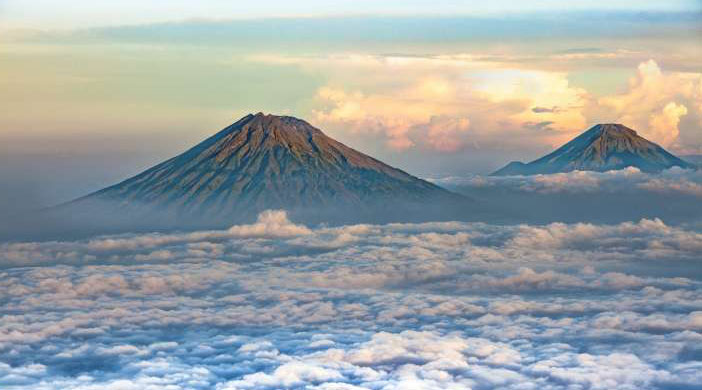
Mexico: Mt. Popocatepetl spewed out a powerful eruption that sent ash hurtling 20,000 feet into the sky Smithsonian - January 15, 2020
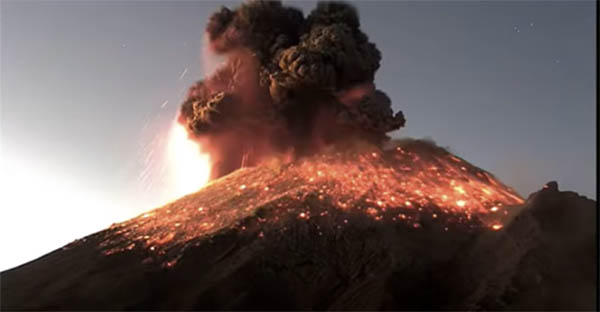
Taal Volcano Eruption in the Philippines is Looking Bad, with Worse to Come Daily Beast - January 15, 2020

Pilot's stunning image of Philippines volcano Taal eruption 9News - January 15, 2020
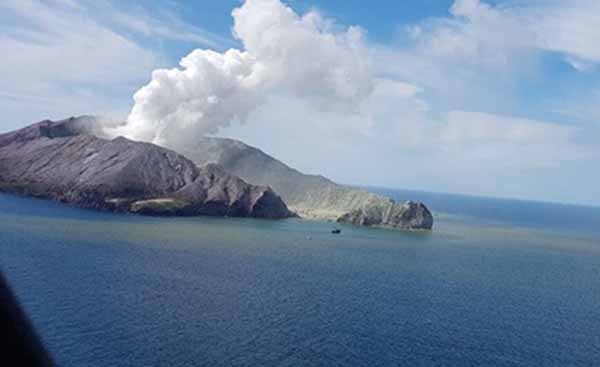
Whakaari / White Island Stratovolcano Erupts Wikipedia - December 9, 2019
Why were tourists allowed on White Island? PhysOrg - December 10, 2019
White Island: A look inside New Zealand's most active volcano PhysOrg - December 10, 2019
White Island volcano: Rescuer tells of 'Chernobyl'-like scene BBC - December 10, 2019
Scientists warn New Zealand's devastating White Island volcano eruption could trigger deadly landslides and tsunamis as they brand tourist trips there 'a disaster waiting to happen' Daily Mail - December 9, 2019
Underwater Volcano Creates Bubbles More Than a Quarter-Mile Across Live Science - October 17, 2019
In the early 20th century, sailors near Alaska reported seeing black bubbles seeming to boil out from the sea, each one the size of the dome of the capitol building in Washington, D.C. They weren't the only sailors who reported the bizarre phenomenon, and they weren't mistaken, except for one thing … the bubbles were much larger. When the mostly underwater Bogoslof volcano in the Aleutian Islands erupts, it produces giant bubbles that can reach up to 1,444 feet (440 meters) across, according to a new study. These bubbles are filled with volcanic gas, so when they burst they create volcanic clouds tens of thousands of feet in the sky, said lead author John Lyons, a research geophysicist at the Alaska Volcano Observatory of the U.S. Geological Survey. These volcanic clouds were captured in satellite images taken after the Bogoslof volcano last erupted in 2017 - but the bubbles themselves were never photographed.
Popocatepetl, one of Mexico's most active volcanoes, erupted 14 times in a single night earlier this week CNN - October 5, 2019
The volcano, which is in central Mexico, between the states of Morelos and Puebla, had been dormant for decades until its eruption in 1994. Since then, its rumblings have become a part of daily life for residents.
Jurassic world of volcanoes found in central Australia PhysOrg - August 13, 2019
An international team of subsurface explorers from the University of Adelaide in Australia and the University of Aberdeen in Scotland has uncovered a previously not described Jurassic world of around 100 ancient volcanoes buried deep within the Cooper-Eromanga Basins of central Australia.
Hidden Water Found on Hawaii's Kilauea Could Mean Explosive Eruptions Live Science - August 6, 2019
Hawaii's Kilauea volcano, which just quieted down after a 30-year active stint, harbors a previously unknown patch of water at the bottommost part of its crater, according to the U.S. Geological Survey. And it might have the potential to trigger explosive eruptions in the future. A couple of weeks ago, a helicopter pilot flying over Kilauea noticed a small, green patch at the bottom of the volcano's crater. The pilot alerted his friend of the mysterious find, who then told his friend, Don Swanson, scientist emeritus at the Hawaiian Volcano Observatory, part of the U.S. Geological Survey (USGS). On Aug. 1, scientists from the observatory flew over the site and confirmed that what they were seeing was in fact water. This is the first time water has been found to exist on the volcano.
Geologists Discover Largest Underwater Volcano, Explain Weird Hum Heard Around the World Live Science - May 23, 2019
A strange seismic event off the coast of Africa has led scientists to a mighty finding: the discovery of the largest underwater volcanic eruption ever recorded. The eruption also may explain a weird seismic event recorded in November 2018 just off the island of Mayotte, located between Madagascar and Mozambique in the Indian Ocean. Researchers described that event as a seismic hum that circled the world, but no one could figure out what sparked it. For starters, the hum rang at a single, ultralow frequency, which was strange because seismic waves usually rumble at many frequencies. Moreover, there were hardly any detectable "p-waves" or "s-waves," which usually accompany earthquakes. And, incredibly, the island of Mayotte moved a few inches south and east after the mysterious event.
From Earth's deep mantle, scientists find a new way volcanoes form PhysOrg - May 16, 2019
Far below Bermuda's pink sand beaches and turquoise tides, geoscientists have discovered the first direct evidence that material from deep within Earth's mantle transition zone-a layer rich in water, crystals and melted rock-can percolate to the surface to form volcanoes.
From Earth's deep mantle, scientists find a new way volcanoes form Science Daily - May 16, 2019
Far below Bermuda's pink sand beaches and turquoise tides, geoscientists have discovered the first direct evidence that material from deep within Earth's mantle transition zone -- a layer rich in water, crystals and melted rock -- can percolate to the surface to form volcanoes.
New evidence suggests volcanoes caused biggest mass extinction ever Science Daily - April 16, 2019
Researchers say mercury buried in ancient rock provides the strongest evidence yet that volcanoes caused the biggest mass extinction in the history of the Earth. The extinction 252 million years ago was so dramatic and widespread that scientists call it 'the Great Dying.' The catastrophe killed off more than 95 percent of life on Earth over the course of hundreds of thousands of years. The extinction 252 million years ago was so dramatic and widespread that scientists call it "the Great Dying." The catastrophe killed off more than 95 percent of life on Earth over the course of hundreds of thousands of years.
California's deadly 'Big One' could be caused by volcanic eruptions: Report warns the state's seven active volcanoes are a ‘nearly forgotten hazard' despite events occurring as often as major San Andreas quakes Daily Mail - February 26, 2019
Californians are all, by now, well aware of the risks posed by the state's more hostile natural forces; from earthquakes to wildfires and landslides, officials have spent decades preparing the public for possible disasters. But, experts say there's one major threat they've largely been sleeping on: volcanoes.
Anak Krakatau: Indonesian volcano's dramatic collapse - the volcano has lost more than two-thirds of its height and volume during the past week BBC - December 29, 2018
The scale of the dramatic collapse of the Indonesian volcano that led to last Saturday's devastating tsunami in the Sunda Strait is becoming clear. Researchers have examined satellite images of Anak Krakatau to calculate the amount of rock and ash that sheared off into the sea.
They say the volcano has lost more than two-thirds of its height and volume during the past week. Much of this missing mass could have slid into the sea in one movement. It would certainly explain the displacement of water and the generation of waves up to 5m high that then inundated the nearby coastlines of Java and Sumatra.
Indonesian tsunami volcano lost two-thirds of its height PhysOrg - December 29, 2018
The Indonesian volcano which caused a tsunami that killed more than 400 people last week lost more than two-thirds of its height following the eruption which triggered the killer waves. A section of Anak Krakatoa's crater collapsed after an eruption and slid into the ocean, generating the tsunami last Saturday night. A visual analysis by the Indonesian volcanology agency found the volcano has lost more than two-thirds of its height, an official said Saturday. Anak Krakatoa which used to stand 338 metres (1,109 feet) high was now just 110 metres tall. The agency estimated the volcano lost between 150 and 180 million cubic metres of material as massive amounts of rock and ash have been slowly sliding into the sea following a series of eruptions.
December 22, 2018 Sunda Strait Volcano Tsunami - North of Christmas Island Wikipedia

A volcano tsunami happened without warning after Anak Krakatau's erupted caused by an undersea landslide. Lying on the Ring of Fire, Indonesia experiences a high frequency of earthquakes and is home to 127 active volcanoes. The catastrophic 2004 Indian Ocean 9.3 earthquake and tsunami happened around the same time of year, occurring on December 26 (Boxing Day), but causing more widespread damage throughout the rim of the Indian Ocean, with countries as far afield as Thailand and Sri Lanka being affected.
Petrified remains of a harnessed horse that died and was frozen in time when Vesuvius erupted nearly 2,000 years ago are discovered in an ancient stable near Pompeii Daily Mail - December 25, 2018
The majestic animal was tall, well-groomed and had a saddle fitted with richly decorated bronze trimmings, experts have revealed. The catastrophic eruption produced hundreds of tonnes of lava and toxic gas which killed and petrified the animal, as well as the other horses in the stable. It was found in the grounds of a large villa in a Pompeii suburb which scientists say may have belonged to a high-ranking military official.
Data from Kilauea suggests the eruption was unprecedented PhysOrg - December 14, 2018
A very large team of researchers from multiple institutions in the U.S. has concluded that the Kilauea volcanic eruption that occurred over this past summer represented an unprecedented volcanic event. Researchers describe the sequence of events that transpired and what set them apart from other volcanic eruptions. Kilauea, a volcano on Hawaii's big island underwent a long, drawn-out eruption over this past summer. It made headlines due to the spread of lava that destroyed many homes and changed some of the island's landscape. And it is now making news again as data from the eruption reveals that it erupted in ways that have not been seen before.
How volcanoes really erupt: Study suggests they are fed by 'mush' reservoirs and not magma chambers Daily Mail - December 4, 2018
A new study could upend our understanding of volcanic eruptions. While it's long been assumed that volcanic processes are driven by massive underground magma chambers, these cavernous features have never been observed. Now, researchers say they may not exist.
Instead of underground caves filled with molten rock, new research suggests volcanoes sit atop ‘mush reservoirs' of small magma pools that form between the gaps of solid, crystalline rocks.
Volcanoes fed by 'mush' reservoirs rather than molten magma chambers PhysOrg - December 4, 2018
Volcanoes are not fed by molten magma formed in large chambers finds a new study, overturning classic ideas about volcanic eruptions. Instead, the study suggests that volcanoes are fed by so-called 'mush reservoirs' - areas of mostly solid crystals with magma in the small spaces between the crystals. Our understanding of volcanic processes, including those leading to the largest eruptions, has been based on magma being stored in liquid-filled 'magma' chambers - large, underground caves full of liquid magma. However, these have never been observed.
New automated volcano warning system forecasts imminent eruptions PhysOrg - November 30, 2018
Scientists have developed an automated early warning system for volcanic eruptions, according to a new study. The new system helped government officials warn the public of impending eruptions in Italy and could potentially do the same around the globe. The new system that monitors volcanic noises and automatically alerts officials if an eruption is imminent. The study's authors tested this system over a period of eight years on Mount Etna, a volcano on the island of Sicily. Using the new system, the Italian government activated an emergency plan about one hour prior to an eruption for the first time in late 2015.
Monitoring air quality on Hawaii's Big Island during the Kilauea eruption PhysOrg - October 24, 2018
A team is working to integrate its mobile sampling data with information from ground stations and satellite images. They plan to create a map of air quality gradients under each wind condition to better understand pollution levels based on the data available during the eruption in May, June and July.
World's Deepest Volcanic Eruption Creates Nightmare Garden of Glass in the Pacific Ocean Live Science - October 24, 2018
This is in the Mariana Trough - a crescent of volcanism, not far from the Mariana Trench. Most of the world's volcanic activity actually takes place in the ocean, but most of it goes undetected and unseen.
Lost Chain of Underwater Volcanoes Is a Massive Whale Superhighway Live Science - October 10, 2018
Thanks to an especially slobbery "Looney Tune," the island of Tasmania is best-known for its eponymous devils. But the nearby Tasman Sea is no less rich in oddball biodiversity. Take, for example, the newest discovery reported by the Australian research vessel the Investigator. A team of seafaring scientists has uncovered an ancient highway of massive underwater volcanoes - and those submerged mountains (or "seamounts") are apparently brimming with whales, according to a news release from Australia's national science agency.
Feds send first emergency message test to cell phones CNN - October 4, 2018

If you have a cell phone, it probably buzzed and beeped loudly Wednesday afternoon October 3, 2018 around 2:18 p.m. ET. "Presidential Alert," the screen said. "THIS IS A TEST of the National Wireless Emergency Alert System. No action is needed." It' was the first nationwide test of the system built by the federal government and cell phone carriers to warn Americans of an emergency, like a terror attack or a widespread disaster.
-
Did your cell phone go off? Mine did as I was talking to a friend in Florida. Her alert was about one minute behind mine. Some people got nothing. I also had a message on my TV. Many people are worried about this being a warning of things to come - be that an enemy attack or a natural disaster. One should always be prepared for anything in End Times.
September 28, 2018 Sulawesi Earthquake and Tsunami Wikipedia
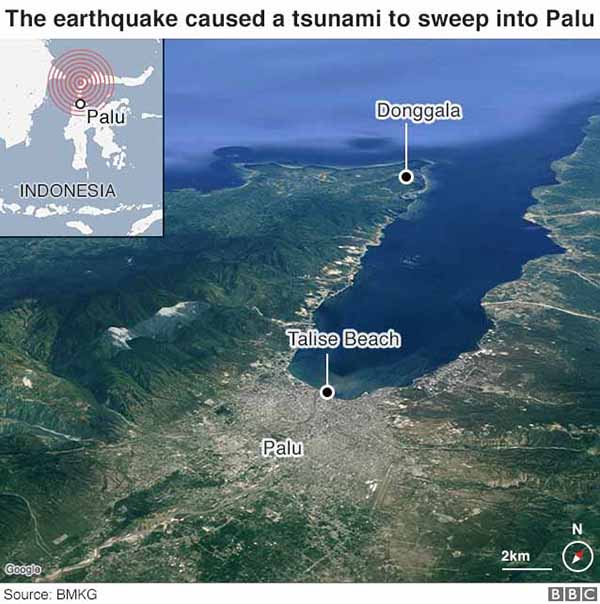
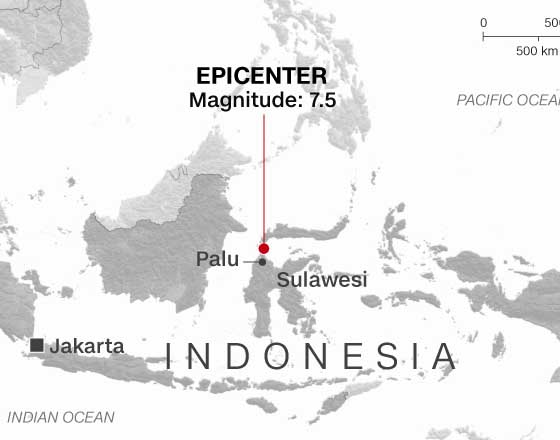
Volcano erupts on Indonesia's quake and tsunami-hit Sulawesi NBC - October 3, 2018
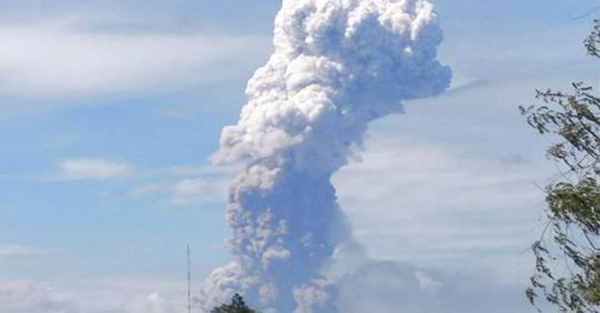
Volcanic activity had been increasing at Mount Soputan since August and began surging Monday, three days after the twin disasters.
Indonesia tsunami: Death toll rises to over 1,200 BBC - October 2, 2018
Indonesia tsunami: Moment quake turns ground into liquid BBC - October 2, 2018
Indonesia tsunami: Aerial shots of debris and survival BBC - October 2, 2018
Why Sulawesi's tsunami is puzzling scientists BBC - October 2, 2018
Huge Cache of Magma Hidden Beneath California Supervolcano Live Science - August 16, 2018
Some 760,000 years ago, before our species took its first steps on Earth, an enormous eruption in what is now eastern California sent high-speed rivers of ash and lava across an area tens of miles across. The event ejected ash as far east as present-day Nebraska. When the dust settled, six days later, the Long Valley supervolcano had disgorged about 1,400 times the volume of lava, gas and ash as the famous 1980 super-eruption of Mount St. Helens in Washington. And since 1978, Long Valley has shown signs of restlessness, with the depressed valley at the center of the volcano (the caldera) showing uplift, possibly from magma moving toward the surface. (Magma is the hot rock stored beneath a volcano that ultimately erupts onto land and is renamed lava.) Some scientists also argue that liquids from stored magma may be causing the uplift.
Lives frozen in ash: Images of Guatemalan homes buried by volcano's eruption NBC - June 14, 2018
At least 110 people were killed when the volcano erupted June 3, sending waves of super-heated debris down onto nearby villages.
Hawaii volcano: How many people do volcanoes kill? BBC - May 27, 2018
With its red-hot rivers of lava and clouds of ash, Hawaii's Kilauea volcano has captured the world's attention. But how dangerous are such eruptions? Every year about 60 volcanoes erupt. Some take us by surprise but others are regular offenders. Kilauea is one of the world's most active - its present eruption began 35 years ago, but there has been an increase in activity in recent weeks. Its lava flows have quite literally been erupting in people's backyards, but thankfully only one serious injury has been reported - a man hit by projectile molten rock as he sat on his balcony. This could appear to suggest that volcanoes aren't all that dangerous, but much of the world's population lives close to an active volcano - and many of these are much deadlier than Kilauea.
Do you live near a volcano that could blow? Interactive map reveals the US areas at risk Daily Mail - May 19, 2018
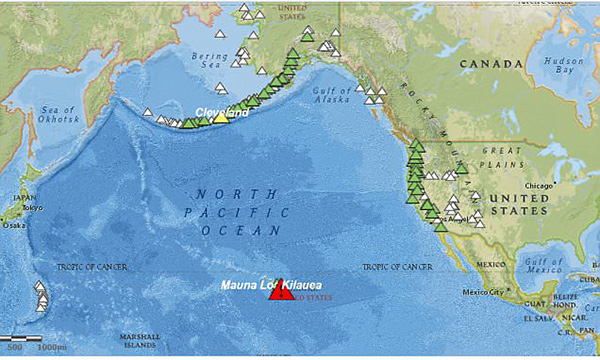
As Hawaii residents deal with the devastating effects of the eruption of the Kilauea volcano, a US Geological Service map has revealed the other US hotspots where residents are at risk of volcanic activity. The United States Geological Survey counts 169 potentially active volcanoes in the country, with about 50 of them in six states are rated high priority or highest priority for monitoring. Alaska tops the at risk areas, with at least 50 volcanoes that have been active since 1760, attracting substantial attention from volcano watchers and researchers.
Mount Etna is sliding towards the sea BBC - March 24, 2018
Europe's most active volcano, Mount Etna, is sliding towards the sea. Scientists have established that the whole structure on the Italian island of Sicily is edging in the direction of the Mediterranean at a rate of 14mm per year. The UK-led team says the situation will need careful monitoring because it may lead to increased hazards at Etna in the future.
Underwater supervolcano could erupt without warning and kill 100 million people after scientists find a 6-mile wide lava dome growing off the coast of Japan Daily Mail - February 13, 2018
Submerged volcano off the coast of Japan that erupted 7,300 years ago could be preparing to make a comeback. Scientists have discovered evidence of a giant dome of lava in the Kikai volcano's collapsed magma chamber. They believe it contains about 32 cubic km (7.68 cubic miles) of magma, and distortions on its surface suggest the dome is growing. Currently the dome is around 6.2 miles (10 kilometers) wide and 1,968 feet (600 meters) tall. Scientists say an eruption could take place without warning, and if it does, it could kill as many as 100 million people and trigger a 'volcanic winter'.
Japan: 8 Trillion 'Gallons'! Huge Blob of Magma Found Atop Undersea Volcano BBC - February 10, 2018
The dome, which is 6.2 miles (10 kilometers) wide and 1,968 feet (600 meters) tall, is solid rock now, and it doesn't presage an impending eruption. However, it does add a new wrinkle to the history of the Kikai caldera, a huge depression that formed during a massive volcanic super-eruption about 6,300 or 7,300 years ago (the broad range has to do with different methods of dating the eruption). That eruption sent heated pyroclastic flow 50 miles (80 km) across the sea and spread ash up to 620 miles (1,000 km) away, said Yoshi Tatsumi, the author of a new study on the caldera's inner workings
The seemingly unremarkable crystals that could help predict volcanic eruptions PhysOrg - January 23, 2018
The crystals form inside the volcano when molten rock - magma - starts moving upwards from depths of up to 30 km towards the Earth's surface. The crystals are carried in the erupting magma, and they often continue to grow as they are being transported. Importantly, they also change in composition on their way to the surface.
 Avalanche kills one in Japan ski resort after volcanic eruption BBC - January 23, 2018
Avalanche kills one in Japan ski resort after volcanic eruption BBC - January 23, 2018
 Alert raised as Mount Mayon volcano spews ash, lava in the Philippines CNN - January 22, 2018
Alert raised as Mount Mayon volcano spews ash, lava in the Philippines CNN - January 22, 2018
Mysterious 'hot air balloon' of molten rock is discovered rising under the surface of New Hampshire - and experts believe it could lead to a volcanic eruption Daily Mail - December 18, 2017
An enormous mass of molten rock hundreds of miles across is rising beneath an idyllic area of the US, a new study has found.
Using advanced geophysical instruments, experts looked at seismic waves - vibrations that pass through our planet following earthquakes - to make the finding. The bulbous upwelling, compared by researchers to a hot air balloon, could one day lead to a volcanic eruption - although this isn't likely for millions of years.
Yellowstone spawned twin super-eruptions that altered global climate PhysOrg - October 26, 2017
A new geological record of the Yellowstone supervolcano's last catastrophic eruption is rewriting the story of what happened 630,000 years ago and how it affected Earth's climate. This eruption formed the vast Yellowstone caldera observed today, the second largest on Earth. Two layers of volcanic ash bearing the unique chemical fingerprint of Yellowstone's most recent super-eruption have been found in seafloor sediments in the Santa Barbara Basin, off the coast of Southern California. These layers of ash, or tephra, are sandwiched among sediments that contain a remarkably detailed record of ocean and climate change. Together, both the ash and sediments reveal that the last eruption was not a single event, but two closely spaced eruptions that tapped the brakes on a natural global-warming trend that eventually led the planet out of a major ice age.
Ice sheets may melt rapidly in response to distant volcanoes PhysOrg - October 24, 2017
Volcanic eruptions have been known to cool the global climate, but they can also exacerbate the melting of ice sheets. Researchers who analyzed ice cores and meltwater deposits found that ancient eruptions caused immediate and significant melting of the ice sheet that covered much of northern Europe at the end of the last ice age, some 12,000 to 13,000 years ago. "Over a time span of 1,000 years, we found that volcanic eruptions generally correspond with enhanced ice sheet melting within a year or so.
New magma pathways after giant lateral volcano collapses PhysOrg - October 24, 2017
Giant lateral collapses are huge landslides occurring at the flanks of a volcano. Giant lateral collapses are rather common events during the evolution of a large volcanic edifice, often with dramatic consequences such as tsunami and volcano explosions. These catastrophic events interact with the magmatic activity of the volcano, as a new research in Nature Communications suggests.
The Popocatepetl volcano outside Mexico City has spewed glowing rock and dumped ash over nearby towns ABC - October 6, 2017
The Popocatepetl volcano outside Mexico City has spewed glowing rock and dumped ash over nearby towns. Mexico's national disaster-prevention agency says the volcano also known to locals as "Don Goyo" erupted for several hours Wednesday morning. Its monitoring cameras detected incandescent rocks landing more than a half-mile (1,000 meters) down the slope. The agency also reported ash fall in towns west of the peak. It said the eruption was not related to the last week's earthquake that killed 337 people. Some 25 million people live within about 60 miles (100 kilometers) of the crater of the 17,797-foot (5,426-meter) stratovolcano. Popocatepetl has been erupting periodically since 1994.
Volcanic Eruptions Gave the Ancient Moon a Temporary Atmosphere Space.com - October 6, 2017
Earth's moon doesn't have much of an atmosphere today. However, it may have had a more prominent atmosphere 3 billion to 4 billion years ago, when volcanic eruptions spewed giant clouds of gas above the lunar surface, a new study has found. Today's moon is covered in dead volcanoes and dark maria, or plains that consist of hardened lava. The lunar atmosphere is so thin it's not even technically an atmosphere - instead, it's considered an "exosphere," with molecules that are gravitationally bound to the moon but are too sparse to behave like a gas.
Yellowstone has now been hit by a record breaking 'megaswarm' of 1,200 earthquakes in just a month Daily Mail - July 21, 2017
In the most recent update on the ongoing earthquake storm, which scientists have been monitoring since June 12, the researchers say there have been 1,284 events so far, with the largest being a magnitude 4.4. While the activity has spurred fears that the supervolcano could be gearing up to an eruption, the experts say the risk of such an event is low, and the alert level remains at ‘normal.'
Mars volcano, Earth's dinosaurs went extinct about the same time PhysOrg - March 20, 2017
Around the same time that the dinosaurs became extinct on Earth, a volcano on Mars went dormant, NASA researchers have learned. Arsia Mons is the southernmost volcano in a group of three massive Martian volcanoes known collectively as Tharsis Montes. Until now, the volcano's history has remained a mystery. But thanks to a new computer model, scientists were finally able to figure out when Arsia Mons stopped spewing out lava. According to the model, volcanic activity at Arsia Mons came to a halt about 50 million years ago. Around that same time, Earth experienced the Cretaceous-Paleogene extinction event, which wiped out three-quarters of its animal and plant species, including the dinosaurs.
 Etna escape: 'Pelted with the deadly, hot debris' BBC - March 17, 2017
Etna escape: 'Pelted with the deadly, hot debris' BBC - March 17, 2017
When we arrived in Sicily, we discovered that we were in luck: Mount Etna had just started to erupt again. I was part of a BBC team who had come to film a report on volcano monitoring. Getting to witness an awakened Etna was about as exciting as it gets for a science correspondent. I just didn't intend to have quite such a close encounter. The conditions were perfect - blue skies and barely any wind. And as we travelled towards the snow-covered summit, the thunderous booms as Etna spewed magma from its south-east crater reverberated all around.
Fossilized tree and ice cores help date huge volcanic eruption 1,000 years ago to within three months PhysOrg - January 24, 2017

An international team of researchers has managed to pinpoint, to within three months, a medieval volcanic eruption in east Asia the precise date of which has puzzled historians for decades. They have also shown that the so-called "Millennium eruption" of Changbaishan volcano, one of the largest in history, cannot have brought about the downfall of an important 10th century kingdom, as was previously thought. Analysis of the partly fossilized remains of a tree killed by the eruption, and ice cores drilled in Greenland, lead them to conclude the eruption occurred in the final months of 946 AD.
Massive 'lake' discovered under volcano could unlock why and how volcanoes erupt Science Daily - November 8, 2016
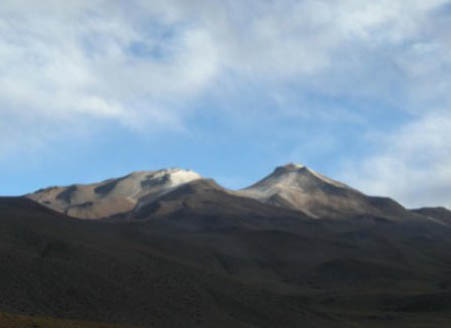
A huge magmatic lake has been discovered, 15 kilometers below a dormant volcano in Bolivia, South America. The body of water, which is dissolved into partially molten rock at a temperature of almost 1,000 degrees Celsius, is the equivalent to what is found in some of the world's giant freshwater lakes, such as Lake Superior. The find has now led scientists to consider if similar bodies of water may be 'hiding' under other volcanoes and could help explain why and how volcanoes erupt.
Researchers find evidence for a cold, serpentinized mantle wedge beneath Mt. St. Helens PhysOrg - November 2, 2016
It's been more than 35 years since the last major eruption of Mount St. Helens. Since that blast, much research has been conducted with scientists learning a great deal about one of the most active volcanoes within the Cascade arc, a North-South chain of volcanoes in the Pacific Northwest that formed above the subducting Juan de Fuca plate.
 Volcano insight: Fifty years of eruptions revealed BBC - October 6, 2016
Volcano insight: Fifty years of eruptions revealed BBC - October 6, 2016
Half a century of the planet's volcanic eruptions and earthquakes have been visualized in an animated app. It is part of a project to create a record of every volcanic eruption on Earth for the last 10,000 years. As well as monitoring active volcanoes, a global collaboration of researchers is gathering evidence of ancient eruptions in the geological record.
3 Volcano Spotted Erupting over a remote archipelago in the South Atlantic Ocean Live Science - October 5, 2016
Three active volcanoes simultaneously erupting and unleashing giant plumes of smoke were spotted by a NASA satellite as it passed over a remote archipelago in the South Atlantic Ocean. The three stratovolcanoes - a type of composite volcano built of layers of lava, ash and stone - are located on the South Sandwich Islands, which are about 1,700 miles (2,800 kilometers) southeast of Buenos Aires, Argentina. Volcanoes in the region are some of the least studied in the world, because of the remote location and inhospitable environment of the islands. On Sept. 29, NASA's Aqua satellite captured the plumes from these volcano triplets in a false-color image. Clouds and ice in the region make it difficult for satellites to see volcanic activity in natural-color imagery, NASA said. False-color images use portions of the electromagnetic spectrum typically invisible to humans such as infrared to distinguish ice from ash and clouds.
Lead found in ink used to write scrolls buried by eruption of Mount Vesuvius PhysOrg - March 22, 2016
For several hundred years, before the dangers of lead were known, lead and other metals were added to ink to aid in color improvement, binding and consistency. But until now, it was believed this practice didn't start until approximately the fourth or fifth centuries AD - prior to then, inks were primarily carbon based. In this new effort, the researchers were studying scrolls that were charred and then covered when Mount Vesuvius erupted in 79 AD, burying the town, and of course nearby Pompeii as well.
Ancient scrolls give up their secrets BBC - March 21, 2016
Metallic ink was used to inscribe scrolls regarded as an archaeological wonder, according to scientists. The discovery pushes back the date for the first use of metallic ink by several centuries. The Herculaneum scrolls were buried by the eruption of Mount Vesuvius in AD79 and are charred and fragile. Previous efforts to read them, over many centuries, has damaged or destroyed some of the scrolls. The task of reading the surviving scrolls has fallen to scientists using technology such as the European synchrotron, which produces X-rays 100 billion times brighter than the X-rays used in hospitals. Last year, physicists used the 3D X-ray imaging technique to decipher writing in the scrolls. The scrolls are the only library known to have survived from classical times
Volcanic eruptions that changed human history Science Daily - July 8, 2015
It is well known that large volcanic eruptions contribute to climate variability. A new study uses new evidence found in both ice cores and corresponding tree rings to show the timing and associated radiative forcing of nearly 300 individual volcanic eruptions extending as far back as the early Roman period.
 Chile's Calbuco volcano erupts for third time BBC - April 30, 2015
Chile's Calbuco volcano erupts for third time BBC - April 30, 2015
>
Chile's Calbuco volcano has erupted for the third time in eight days, leading the government to order the evacuation of 2,500 people. Some of those residents had only just returned to their homes after last week's eruptions. The latest eruption was less powerful, but sent a large plume of dark grey smoke and ash rising from the crater. Calbuco surprised residents of the Los Lagos region last week by bursting into life after 54 years of inactivity.
Lava Lake Threatens Overflow in Hawaii Live Science - April 28, 2015
The roiling lava lake atop Hawaii's Kilauea Volcano is threatening to overflow for the first time since the molten pool appeared in February 2010. The lava lake usually hides out of tourists' sight by hovering about 100 feet (30 meters) below the rim of Overlook crater, which lies inside of the bigger Halemau'mau' crater at Kilauea's summit. The 720-foot wide (220 m) Overlook crater emerged with a stupendous blast on March 19, 2008. But last week, on April 22, lava started rising steadily and is now hovering within 10 feet (3 m) of the crater's edge. Lava briefly touched the crater rim this morning (April 28), according to the U.S. Geological Survey's Hawaiian Volcano Observatory.
Titanic Blob of Magma Found Beneath Yellowstone Supervolcano Live Science - April 23, 2015
A giant blob-shaped reservoir of searing-hot rock has been discovered far below the supervolcano underneath Yellowstone National Park - one that could fill the Grand Canyon more than 11 times over, researchers say. The discovery doesn't raise the risk of future eruptions at Yellowstone, the study authors said. However, a better understanding of the Yellowstone supervolcano's plumbing could shed light on any hazards it might pose, scientists added. The newfound blob-shaped magma reservoir lies in the lower crust. The molten rock extends from about 12 to 28 miles (19 to 45 kilometers) deep, and measures about 30 miles (48 km) long northwest to southeast and 44 miles (70 km) long southwest to northeast. This magma reservoir is about 11,200 cubic miles (46,700 cubic km) in size.
An Antarctic volcano that just doesn't make any sense PhysOrg - April 7, 2015
Only two volcanoes in Antarctica are active. There is Mount Erebus, which is roughly due south of New Zealand, and Deception Island, which lies about 850km south east of Cape Horn. Mt Erebus has been erupting continuously over the last few decades. Yet the rather smaller Deception Island, in the South Shetland archipelago, is responsible for the largest known eruption in the Antarctic area.
This horseshoe-shaped cauldron-like structure, or caldera, was produced more than 10,000 years ago by an explosive eruption that scattered more than 30km3 of molten rock. The result is an enclosed welcoming bay called Port Foster. The big blunder ...
What is a Dirty Thunderstorm? BBC - March 26, 2015
A series of astounding images of a 'dirty thunderstorm', captured by volcano film-maker Marc Szeglat earlier this month, show the earth's power at its most terrifying and breath-taking.
Dirty thunderstorms are a rare phenomenon, associated with large volcanic eruptions. But unusually and perhaps uniquely, they occur regularly at Sakurajima volcano in Japan, one of the most active volcanoes in the world.
A Visit to the Forgotten Volcano That Once Turned Europe Dark Wired - January 22, 2015
One of the craters of Iceland's Laki volcano, which had a huge eruption in 1783 that darkened Europe and had global consequences.
Laki Wikipedia
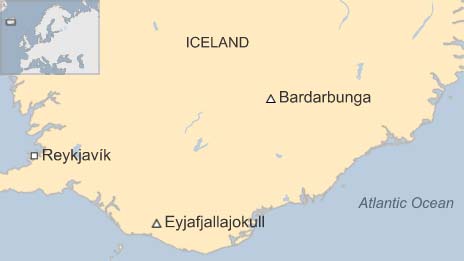
Iceland volcano: Bardarbunga hit by 5.7 earthquake BBC - August 26, 2014
Iceland's Bardarbunga volcano was hit by a magnitude 5.7 earthquake on Tuesday morning, the largest since tremors began in the area last week. The country's Met Office said despite the shock - the fourth magnitude five quake in 48 hours - there is still no sign of a volcanic eruption. On Sunday, Iceland lowered the aviation risk to its second highest level. Iceland's Eyjafjallajokull volcano erupted in 2010, producing ash that disrupted air travel across Europe. Bardarbunga is in a different range to Eyjafjallajokull, but the intense seismic activity has raised fears that an eruption could cause similar travel chaos.
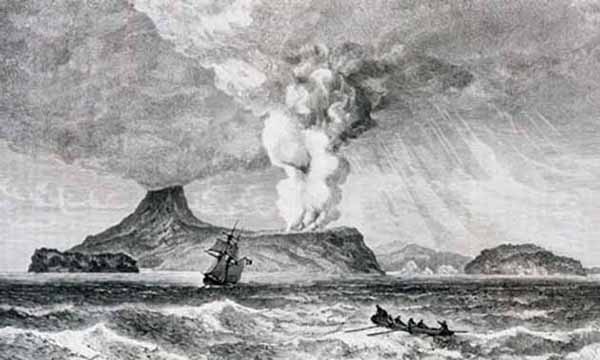

Krakatoa is a volcanic island situated in the Sunda Strait between the islands of Java and Sumatra in Indonesia. The name is also used for the surrounding island group comprising the remnants of a much larger island of three volcanic peaks which was obliterated in a cataclysmic 1883 eruption, unleashing huge tsunamis (killing more than 36,000 people) and destroying over two-thirds of the island. The explosion is considered to be the loudest sound ever heard in modern history, with reports of it being heard up to 3,000 miles (4,800 km) from its point of origin. The shock waves from the explosion were recorded on barographs around the globe. In 1927 a new island, Anak Krakatau, or "Child of Krakatoa", emerged from the caldera formed in 1883 and is the current location of eruptive activity.
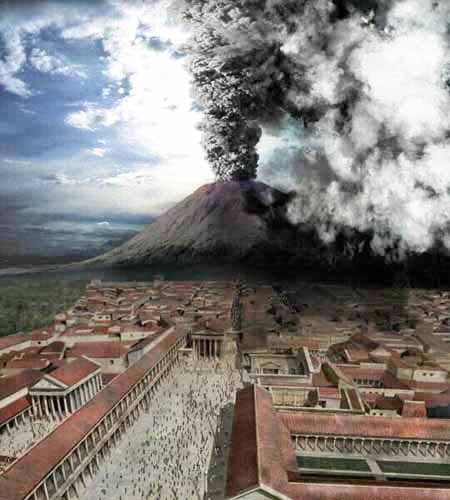
Mount Vesuvius erupts. The cities of Pompeii, Herculaneum, and Stabiae are buried in volcanic ash. Very fine ash particles remain high in the atmosphere for years, spreading around the world by high-altitude winds. This suspended material contributes to often spectacular sunsets, as well as an optical phenomenon known as Bishop's Ring.
Shattering past of the 'island of glass': Pantelleria, a little-known island near Sicily, was once covered in a searing-hot layer of green glass Science Daily - May 21, 2014

A tiny Mediterranean island visited by the likes of Madonna, Sting, Julia Roberts and Sharon Stone is now the focus of a ground-breaking study by geologists. Pantelleria, a little-known island between Sicily and Tunisia, is a volcano with a remarkable past: 45 thousand years ago, the entire island was covered in a searing-hot layer of green glass.
Found! New Underwater Volcano Discovered in Hawaii Live Science - May 17, 2014
The sprawling chain of Hawaiian volcanoes just added another underwater branch. The discovery means Oahu once towered above the ocean with three volcanic peaks, the researchers said. Until now, scientists thought Oahu was built by two volcanoes - Wai'anae on the west and Ko'olau on the east. "I think we may very well have had three active volcanoes in the Oahu region," said lead study author John Sinton, a geologist at the University of Hawaii at Manoa.
Rare Earthquake Warning Issued for Oklahoma Live Science - May 5, 2014
Mile for mile, there are almost as many earthquakes rattling Oklahoma as California this year. This major increase in seismic shaking led to a rare earthquake warning today (May 5) from the U.S. Geological Survey and the Oklahoma Geological Survey. In a joint statement, the agencies said the risk of a damaging earthquake - one larger than magnitude 5.0 - has significantly increased in central Oklahoma. Geologists don't know when or where the state's next big earthquake will strike, nor will they put a number on the increased risk. "We haven't seen this before in Oklahoma, so we had some concerns about putting a specific number on the chances of it," Robert Williams, a research geophysicist with the USGS Earthquake Hazards Program in Golden, Colorado, told Live Science. "But we know from other cases around the world that if you have an increasing number of small earthquakes, the chances of a larger one will go up."
Volcanic islands merge in Pacific Ocean BBC - April 8, 2014
A volcanic island in the Pacific Ocean has merged with its neighbor to form one landmass, the US space agency says. The merged island lies some 1,000km (621mi) south of Tokyo, the result of eruptions on the seafloor that have spewed enough material to rise above the water line. In November 2013, a new island sprouted near to Nishino-shima, another volcanic landmass that last expanded in the 70s. Four months later, the new and old islands are one island. The newer portion of the island - which was referred to as Niijima - is now larger than the original Nishino-shima landmass.
 Strangest Magma on Earth: Carbonatites of Ol Doinyo Lengai Wired - March 11, 2014
Strangest Magma on Earth: Carbonatites of Ol Doinyo Lengai Wired - March 11, 2014
If you had to pick the most unique volcano on Earth, you'd be hard pressed to find a better candidate than Tanzania's Ol Doinyo Lengai. Not only does it look like a volcano designed by HR Giger (below), but it is the only place on the planet that is currently erupting carbonatite lava, some of the strangest stuff you will ever see. These lavas are like no other lava, chock full of calcium, sodium and carbon dioxide, leading to some of the odd properties of these eruptions. However, the ultimate source of these carbonatite lavas is still hotly debated - and to make it more complicated, Ol Doinyo Lengai doesn't even erupt the usual carbonatite (if you can call any carbonatite usual) lava. Not only that, but carbonatites might be a good source for mining rare earth elements, so understanding how they form is going to become increasingly important.
Ancient Helium Escaping from Yellowstone Live Science - February 19, 2014
The giant magma blob beneath Yellowstone National Park unleashed tons of ancient helium gas when it torched North America, according to a new study. "The amount of crustal helium coming out is way more than anyone would have expected," said Jacob Lowenstern, lead study author and scientist-in-charge at the U.S. Geological Survey's Yellowstone Volcano Observatory. The findings appear in today's (Feb. 19) issue of the journal Nature. Yellowstone National Park's famous geysers burble within the remains of a supervolcano that first exploded 2.1 million years ago. Both the volcano and the geysers owe their existence to a hotspot, a massive plume of molten rock rising from within Earth's mantle toward the surface.
Supervolcano eruption mystery solved BBC - January 6, 2014
Supervolcanoes like Yellowstone can explode without an earthquake or other external trigger, experts have found. The sheer volume of liquid magma is enough to cause a catastrophic super-eruption.
Scientists show how deadly volcanic phenomenon moves PhysOrg - December 30, 2013
For the first time scientists have tracked how one of the deadliest volcanic hazards moves over time. Scientists from the University of Leicester have developed a novel way of reconstructing how one of these currents flowed. Their technique showed for the first time that instead of flowing radially out from the volcano and covering everything in their path, these currents move initially in one direction, but that this direction then changes.
Utah supervolcanoes discovered PhysOrg - December 10, 2013
Brigham Young University geologists found evidence of some of the largest volcanic eruptions in earth's history right in their own backyard. These supervolcanoes aren't active today, but 30 million years ago more than 5,500 cubic kilometers of magma erupted during a one-week period near a place called Wah Wah Springs. By comparison, this eruption was about 5,000 times larger than the 1980 Mount St. Helens eruption. In southern Utah, deposits from this single eruption are 13,000 feet thick. Imagine the devastation – it would have been catastrophic to anything living within hundreds of miles. Dinosaurs were already extinct during this time period, but what many people don't know is that 25-30 million years ago, North America was home to rhinos, camels, tortoises and even palm trees. Evidence of the ancient flora and fauna was preserved by volcanic deposits.
Volcanic eruption raises new island in Pacific's 'Ring of Fire' NBC - November 21, 2013
A volcanic eruption has raised a new island, according to earthquake experts and the Japanese coast guard. Advisories from the coast guard and the Japan Meteorological Agency said the islet is about 660 feet in diameter. It is just off the coast of Nishinoshima, a small, uninhabited island in the Ogasawara chain, which is also known as the Bonin Islands.
Stunning Pictures: Japan's New Volcanic Island Live Science - November 21, 2013
A new island appeared in the Pacific Oceans about 620 miles (1,000 km) south of Tokyo on Nov. 20. The spectacular volcanic eruption boiled the sea and shot lava fragments into the air. The Japanese Coast Guard captured pictures of the island's birth from the air.
'World's largest volcano discovered beneath Pacific BBC - September 8, 2013
Scientists say that they have discovered the single largest volcano in the world, a dead colossus deep beneath the Pacific waves.
A team writing in the journal Nature Geoscience says the 310,000 sq km (119,000 sq mi) Tamu Massif is comparable in size to Mars' vast Olympus Mons volcano - the largest in the Solar System. The structure topples the previous largest on Earth, Mauna Loa in Hawaii. The massif lies some 2km below the sea.
Monster Earth Volcano One of Solar System's Biggest Discovery - September 6, 2013
The largest volcano on Earth is not in Hawaii, but hidden beneath the western Pacific Ocean and covers an area the size of New Mexico. The vast lump of lava is called the Tamu Massif and lies about 1,000 miles (1,600 km) east of Japan and is comparable, though somewhat less voluminous, than the enormous volcano Olympus Mons on Mars.
Largest volcano on Earth found, scientists say CNN - September 6, 2013
An underwater volcano dubbed Tamu Massif was found some 1,000 miles east of Japan, says William Sager, a professor at the University of Houston, who led a team of scientists in the discovery. The volcano is about the size of the state of New Mexico and is among the largest in the solar system, Sager says. Tamu Massif covers an area of about 120,000 square miles. In comparison, the largest active volcano on Earth, Hawaii's Mauna Loa, is about 2,000 square miles, Sager says. "It's shape is different from any other sub-marine volcano found on Earth, and it's very possible it can give us some clues about how massive volcanoes can form," Sager says. Tamu Massif is believed to be about 145 million years old, and became inactive within a few million years after it was formed.
List of Volcanoes in Japan Wikipedia
Volcanic 'scream' precedes explosive eruptions BBC - July 15, 2013
A change in the frequency of earthquakes may foretell explosive volcanic eruptions, according to a new study. The seismic activity changes from steady drum beats to increasingly rapid successions of tremors. These blend into continuous noise which silences just before explosion.
The seriously hot sport of volcano boarding FOX - June 27, 2013
There's nothing like careening down an active volcano in Western Nicaragua. Especially while your feet are strapped to a retrofitted snowboard, ash is flying to and fro and the hot wind is tousling your hair. For adventure-seekers, like Joshua Berman, co-author of the Moon Nicaragua travel guide, it sounds quite thrilling. In fact, he was one of the first to try the unusual sport of volcano boarding in 2004 when it was just getting started.
Ancient Irish texts show volcanic link to cold weather BBC - June 6, 2013

Researchers have been able to trace the impact of volcanic eruptions on the climate over a 1200 year period by assessing ancient Irish texts. The international team compared entries in these medieval annals with ice core data indicating volcanic eruptions. Of 38 volcanic events, 37 were associated with directly observed cold weather extremes recorded in the chronicles. In the dim light of the Dark Ages, the Irish literary tradition stands out like a beacon. At monastic centres across the island, scribes recorded significant events such as feast days, obituaries and descriptions of extreme cold and heat.
A Blast of a Find: 12 New Alaskan Volcanoes Live Science - May 31, 2013
In Alaska, scores of volcanoes and strange lava flows have escaped scrutiny for decades, shrouded by lush forests and hidden under bobbing coastlines. In the past three years, 12 new volcanoes have been discovered in Southeast Alaska, and 25 known volcanic vents and lava flows re-evaluated, thanks to dogged work by geologists with the U.S. Geological Survey (USGS) and the U.S. Forest Service. Sprinkled across hundreds of islands and fjords, most of the volcanic piles are tiny cones compared to the super-duper stratovolcanoes that parade off to the west, in the Aleutian Range. But the Southeast's volcanoes are in a class by themselves, the researchers found. A chemical signature in the lava flows links them to a massive volcanic field in Canada. Unusual patterns in the lava also point to eruptions under, over and alongside glaciers, which could help scientists pinpoint the size of Alaska's mountain glaciers during past climate swings.
Second Source of Potentially Disruptive Icelandic Volcanoes Found Science Daily - April 2, 2013
New research by The Open University and Lancaster University discovered another type of Icelandic volcanic eruption that could cause disruption. Published in Geology (February 2013), the team found magma that is twice as 'fizzy' as previously believed, which increases the likelihood of disruptive ash clouds from future eruptions. Many of the largest explosive eruptions in Iceland involve a viscous, high-silica magma called rhyolite, and are driven by volcanic gases (mostly water and carbon dioxide). It is these gases that give a volcanic eruption its fizz. At depth these gases are dissolved within the magma, but as the magma rises towards the surface during an eruption, the gases expand dramatically, causing the magma to froth and accelerate upwards as a foam. The viscous rhyolite foam breaks down into tiny ash fragments which form the ash clouds.
Unmanned Planes Fly Through Poisonous Volcanic Fumes Live Science - April 2, 2013
Planes designed for urban warfare are helping scientists track poisonous volcanic gas. The Dragon Eye remote-controlled plane weighs in at just under 6 pounds (2.7 kilograms), with a 3.75-foot (1.14 meters) wingspan and two electric motors. Designed for the U.S. Marine Corps, the plane is light enough to carry and launch for reconnaissance. NASA recently acquired three retired Dragon Eye planes and sent them to Costa Rica to monitor Turrialba Volcano. Ongoing sulfur dioxide gas emissions from the volcano create vog, or sulfur dioxide smog, which wreaks havoc on crops and harms people who are sensitive to atmospheric pollutants.
The Deadliest Volcano Ever Discovery - April 2, 2013
The damning evidence keeps rolling in with regards to volcanoes and mass extinctions. The latest is in the journal Geology regarding the mother of all extinction events - the end-Permian event 252 million years ago. The new evidence is from the Salt Range in Pakistan, where fossil plants reveal a huge input of carbon dioxide into the atmosphere that yanked the global climate into a new regime.
It's Been a Blast! Alaska Volcano Observatory Marks 25th Live Science - April 2, 2013
America's busiest cargoairport is in Anchorage, Alaska, where international flights heading to and from the Far East make frequent stops. The Alaska Volcano Observatory (AVO), celebrating its 25th anniversary this month, monitors volcanic eruptions that can wreak havoc on the busy air traffic. For Alaska, a state that depends on air travel for moving people and goods to its far-flung and remote towns and villages, it's critical to know when and where to expect a volcanic plume.
Research team discovers third type of volcanic eruption PhysOrg - January 21, 2013
On land, when a volcano erupts, it does so in either a violent fiery explosion, or as a seeping flow of hot magma. Until now, scientists have believed the same was true for eruptions that occur under the oceans. In this new effort, the researchers have found evidence that some underwater volcanoes erupt in a way that is neither - instead they erupt in a way that is in-between. The new discovery came about as the team was studying pumice from a volcanic eruption that occurred in the Macauley volcano - far beneath the waves in the southwest Pacific Ocean.
They noted that the samples they had sported evenly spread bubble cavities on the inside, and not so even bubbles near their surface - a pattern not generally found with rock spewed from explosive volcanoes. Bubbles form in pumice as gases inside try to escape - it generally happens when volcanic rock is blasted from its source. After more analysis and some out-of-the-box thinking, the team deduced that their pumice sample came to its unique characteristics due to something that happens under the sea. They suggest that had the volcano erupted on land, it would have blown its top, but because of the incredible pressure exerted by the weight of the ocean above it, it wasn't able to do so. Instead, it grew slowly into a mushy mousse-like mound that rose and grew slowly from the volcano, then broke apart, creating small balloons of material they team calls "blebs."
Weird Underwater Volcano Discovered Near Baja Live Science - December 14, 2012
Scientists have discovered one of the world's weirdest volcanoes on the seafloor near the tip of Baja, Mexico. The petite dome - about 165 feet tall (50 meters) and 4,000 feet long by 1,640 feet wide (1,200 m by 500 m) - lies along the Alarcon Rise, a submarine depression located on the seabed at the southern end of the Gulf of California. Tectonic forces are tearing the Earth's crust apart at the spreading center, creating a long rift where magma oozes toward the surface, cools and forms new ocean crust. Circling the planet like baseball seams, seafloor-spreading centers (also called midocean ridges) produce copious amounts of basalt, a low-silica content lava rock that makes up the ocean crust. (Silica, or silicon dioxide, is the main component of quartz, one of the most common minerals on Earth.)
Giant 'balloon of magma' inflates under Santorini PhysOrg - September 9, 2012
A new survey suggests that the chamber of molten rock beneath Santorini's volcano expanded 10-20 million cubic metres - up to 15 times the size of London's Olympic Stadium - between January 2011 and April 2012. The findings are helping scientists to understand more about the inner workings of the volcano which had its last major explosive eruption 3,600 years ago, burying the islands of Santorini under metres of pumice. However, it still does not provide an answer to the biggest question of all: 'when will the volcano next erupt?'
'Maars' Volcanoes: Research Seeks to Understand Strange Eruptions Live Science - August 21, 2012
Maars are not your typical volcanoes. These explosive geological oddities don't form neat, cone-shaped mountains. Rather, they can crop up just about anywhere within certain volcanically active areas. Maars are created when a rising plume of magma interacts with underground water, creating a mixture that bursts out of the ground without much warning.
Earthquakes Reveal Magma Plumbing Beneath Volcanoes Live Science - July 20, 2012
A helicopter battled near-hurricane-force winds as a team of seismologists fought its way through a treacherous mountain pass to reach the Alaska Peninsula's Katmai area. Their goal: to install a network of seismometers around the Katmai Volcanoes, the source of the largest volcanic eruption since Indonesia's Mount Tambora in 1815. Four years and mounds of data later, the team is beginning to understand the plumbing system beneath that group of volcanoes, including the magma source for the 1912 Novarupta eruption, which spewed 3 cubic miles (12 cubic kilometers) of magma and dwarfed the 1980 Mount St. Helens eruption 30 times over.
Earliest Baby Animals Preserved in Ancient Volcanic Ash Live Science - June 30, 2012
The ash from a Pompeii-style volcanic eruption more than a half-billion years ago smothered a nursery of what may be some of the earliest known animals, researchers say. These well-preserved findings shed light on the evolution of early life on Earth, and reinforce evidence suggesting that life became more complex earlier than often suspected, investigators added. Scientists hunted for evidence of life from the mysterious Ediacaran period, when the first complex multicellular organisms appeared about 540 million to 635 million years ago. The life-forms from the Ediacaran are typically bizarre, and very difficult to link with any modern animal groups. In fact, just this week researchers announced they'd discovered tiny tracks from the earliest complex life, bilaterally symmetrical animals that looked like slugs
Seismic Hazard: Faults Discovered Near Lake Tahoe Could Generate Earthquakes Ranging from 6.3 to 6.9 Science Daily - May 24, 2012
Results of a new U.S. Geological Survey study conclude that faults west of Lake Tahoe, Calif., referred to as the Tahoe-Sierra frontal fault zone, pose a substantial increase in the seismic hazard assessment for the Lake Tahoe region of California and Nevada, and could potentially generate earthquakes with magnitudes ranging from 6.3 to 6.9. A close association of landslide deposits and active faults also suggests that there is an earthquake-induced landslide hazard along the steep fault-formed range front west of Lake Tahoe.
Smokin' hot island rises up from depths of the Red Sea NBC - December 28, 2011
The Red Sea has a new inhabitant: a smoking island. The island was created by a wild eruption that occurred in the Red Sea earlier this month. It is made of loose volcanic debris from the eruption, so it may not stick around long.
As seen from space: Volcanic eruption creates new island in the red sea PhysOrg - December 28, 2011
Looking for some new lake-front property? Here's the newest available on the planet. Volcanic activity in the Red Sea that started in mid-December has created what looks like a new island. The Advanced Land Imager (ALI) on NASA's Earth Observing-1 (EO-1) satellite captured a high-resolution, natural-color image on December 23, 2011 showing an apparent island where previously there was none. Here, a thick plume of volcanic ash still rises from the new island.
Volcanic eruption could give rise to new island in the Canaries Telegraph.co.uk - December 5, 2011
For more than a month, burning lava and gases have been spewing up through the sea bed three miles south of El Hierro, the smallest of the seven Canary Islands. The eruption is part of the long-term volcanic evolution of the Canary Islands, which could either result in an entirely new island, or add additional territory to the southern coast of El Hierro.
Earth's First Life Rode Rafts Across Sea, Study Suggests Live Science - September 13, 2011
Floating rafts of volcanic rock could have been cradles of life in the early days of Earth, some scientists suggest.The circumstances under which life emerged sometime before 3.5 billion years ago remain largely mysterious. Commonly believed settings for the origin of life include deep-sea hydrothermal vents. Now scientists in England and Australia suggest that rafts of pumice, which is essentially solidified lava froth, were instrumental as vessels for first life. This pale volcanic rock, which is rich in gas bubbles, is the only known rock type that naturally floats on the surface of the sea.
Volcano blasts tower of ash near Mexico City MSNBC - June 3, 2011
The Popocatepetl volcano that towers over Mexico City began rumbling again Friday, shooting a blast of ash about 2 miles above its crater at dawn. The ash cloud drifted first to the west and then turned back east toward the city of Puebla, Mexico's national disaster prevention agency said.
Bleach in the Icelandic Volcanic Cloud Science Daily - May 27, 2011
One year after the Eyjafjallajökull volcano in Iceland brought European air traffic to a standstill its ash plume revealed a surprising scientific finding: Researchers at the Max Planck Institute for Chemistry in Mainz found that the ash plume contained not only the common volcanic gas sulfur dioxide, but also free chlorine radicals. Chlorine radicals are extremely reactive and even small amounts can have a profound impact on local atmospheric chemistry.
New explanation for Hawaiian hot spot PhysOrg - May 27, 2011
Scientists in the US have suggested that volcanic activity in Hawaii could be fed by a giant hot rock pool 1,000 kilometers west of the islands and in the Earth's mantle, rather than being fed by a hot plume of magma as previously thought.
Hawaii's long-accepted birth story - that the volcanic islands were, and are, fueled by a hot-rock plume running directly to Earth's scorching core - could be toast, a new study hints. Scientists say they've finally found solid evidence of a giant mass of hot rock under the seafloor in the region. But it's not a plume running straight from the core to the surface - and it's hundreds of miles west of the nearest Hawaiian island. Until now, the researchers say, good seismic data on the region has been scarce, so there was no real reason to question the most obvious explanation: that a stream of hot rock directly from around Earth's core formed the 3,100-mile-long (5,000-kilometer-long) chain of islands and undersea mountains in the Pacific Ocean.
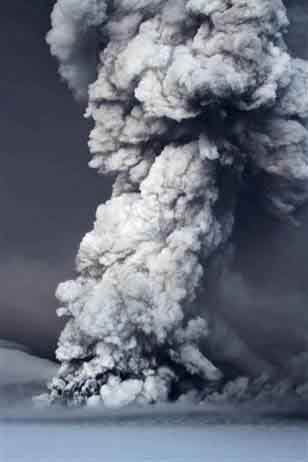

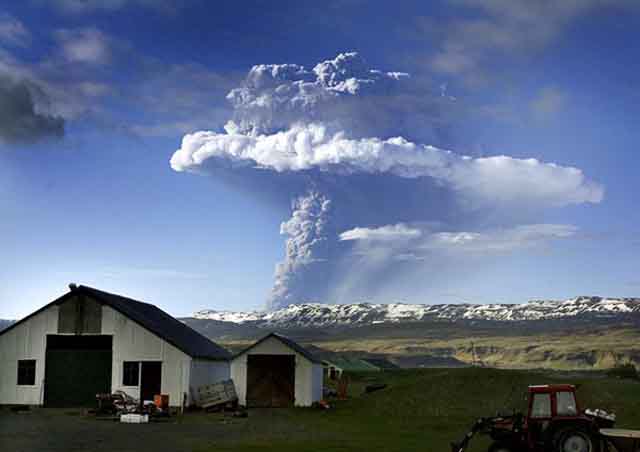
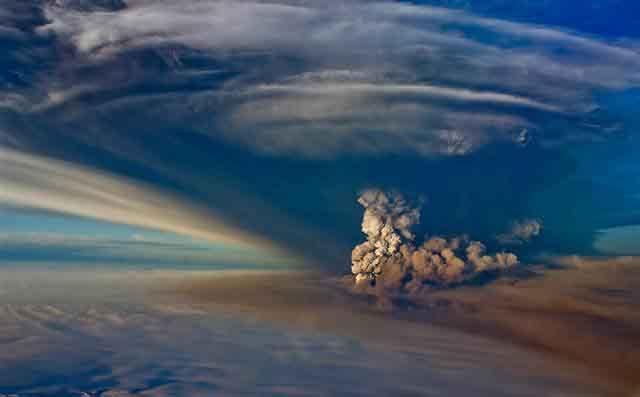
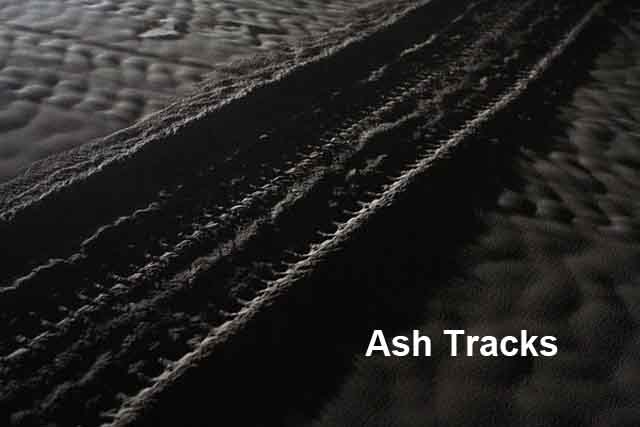
Largest Fossil Spider Found in Volcanic Ash Live Science - April 20, 2011
The largest fossil spider uncovered to date once ensnared prey back in the age of dinosaurs, scientists find. The spider, named Nephila jurassica, was discovered buried in ancient volcanic ash in Inner Mongolia, China. Tufts of hairlike fibers seen on its legs showed this 165-million-year-old arachnid to be the oldest known species of the largest web-weaving spiders alive today - the golden orb-weavers, or Nephila, which are big enough to catch birds and bats, and use silk that shines like gold in the sunlight.
Huge volcano under Yellowstone Park rising MSNBC - February 9, 2011
The huge volcano under Yellowstone National Park has been rising at an unprecedented rate during the past several years, according to a new study. In the ancient past, the Yellowstone volcano produced some of the biggest-known continental eruptions, but the recent rising doesn't mean another doomsday eruption is looming, scientists say.
Geologist's discoveries resolve debate about oxygen in Earth's mantle PhysOrg - December 15, 2010
Analysis of erupted rock from Agrigan volcano in the western Pacific near Guam found it to be highly oxidized as a result of its exposure to oxygen when it formed in the Earth's mantle. When, over millions of years, seafloor rocks are transported back into the Earth's mantle at subduction zones - sites on the seafloor where tectonic plates have collided, forcing one plate beneath the other - they deliver more oxygen into the mantle.
October 2010 Sumatra Earthquake and Tsunami Wikipedia
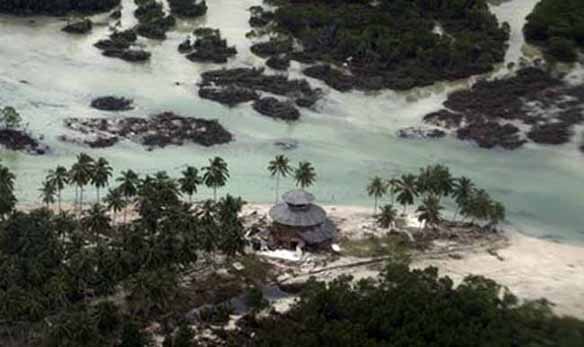
The country's most volatile volcano, Mount Merapi,
800 miles (1,300 kilometers) to the east, erupted.

Both events fell along Indonesia's portion of the Pacific Ring of Fire, a
series of fault lines that are prone to earthquakes and volcanic activity
stretching from the Western Hemisphere through Japan and Southeast Asia.
Indonesia's Explosive Geology Explained Live Science - October 26, 2010
Indonesia is a dangerous country to call home. Precariously located above the grinding and mashing of several tectonic plates, and ringed by a chain of fire-breathing volcanoes, the country's islands are located in one of the most volatile regions in the world. The eruption of a volcano and the shaking of a tsunami-generating earthquake this week is just one reminder of Indonesia's fiery foundation.
Iceland's volcanic eruption yields ash clues BBC - September 28, 2010
Samples collected using double-sided sticky tape could give fresh insight into the Eyjafjallajoekull eruption. The samples could reveal how fine ash thrown up into the atmosphere by the Icelandic eruption fell to ground as clumps or "aggregates" of ash. The eruption of the volcano in March this year caused chaos, shutting down huge swathes of European air space.
Volcano quiet for 400 years erupts in Indonesia PhysOrg - August 29, 2010
Mount Sinabung spews volcanic smoke as it erupts in Karo, North Sumatra, Indonesia, Sunday, Aug. 29, 2010. The volcano spewed hot lava and sand high into the sky early Sunday in its first eruption in 400 years causing thousands of people living around its slope to evacuate their homes.
New insights into volcanic activity on the ocean floor PhysOrg - June 16, 2010
New research reveals that when two parts of the Earth's crust break apart, this does not always cause massive volcanic eruptions. The study, published today in the journal Nature, explains why some parts of the world saw massive volcanic eruptions millions of years ago and others did not. The Earth's crust is broken into plates that are in constant motion over timescales of millions of years. Plates occasionally collide and fuse, or they can break apart to form new ones. When the latter plates break apart, a plume of hot rock can rise from deep within the Earth's interior, which can cause massive volcanic activity on the surface. When the present-day continent of North America broke apart from what is now Europe, 54 million years ago, this caused massive volcanic activity along the rift between the two. Prior to today's study, scientists had thought that such activity always occurred along the rifts that form when continents break apart.